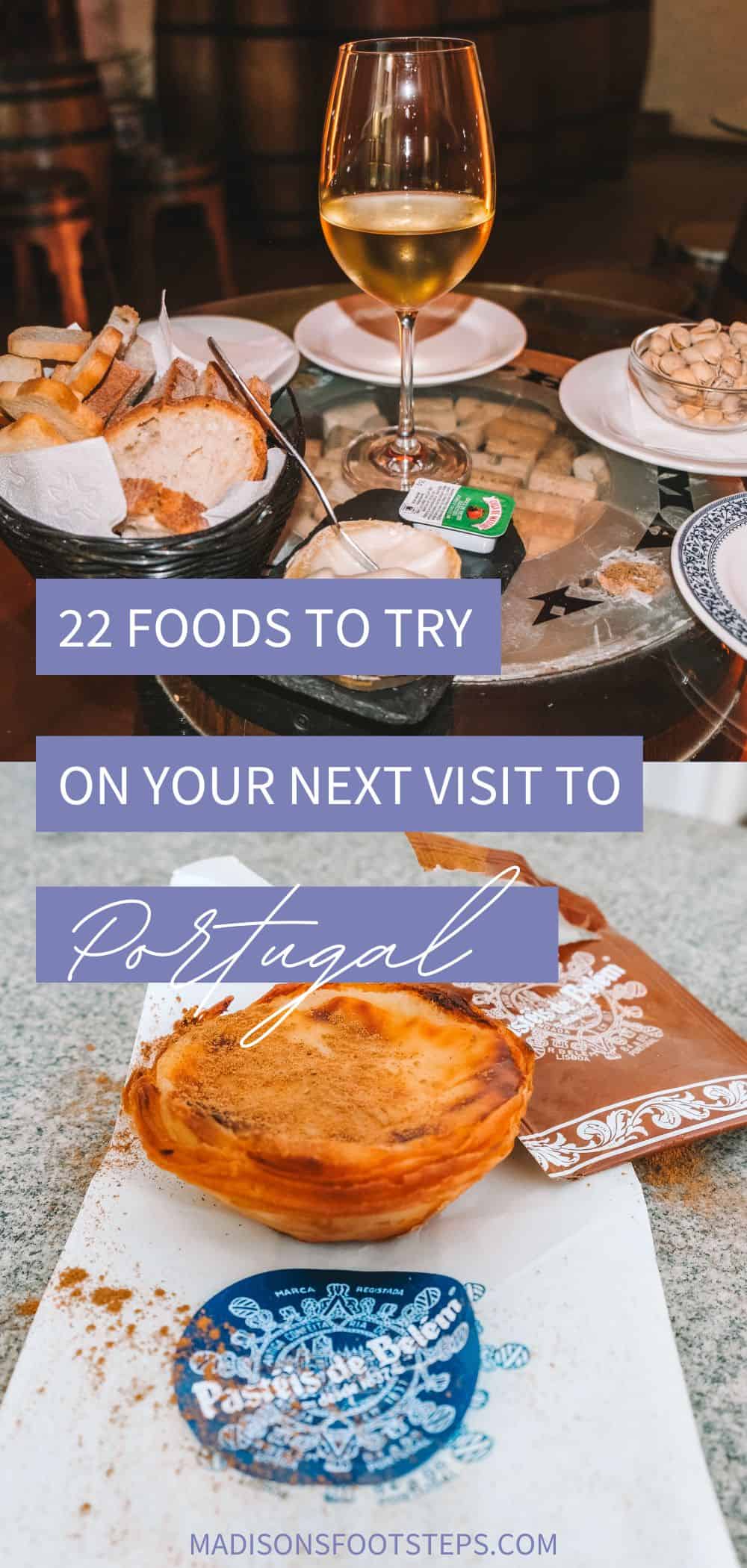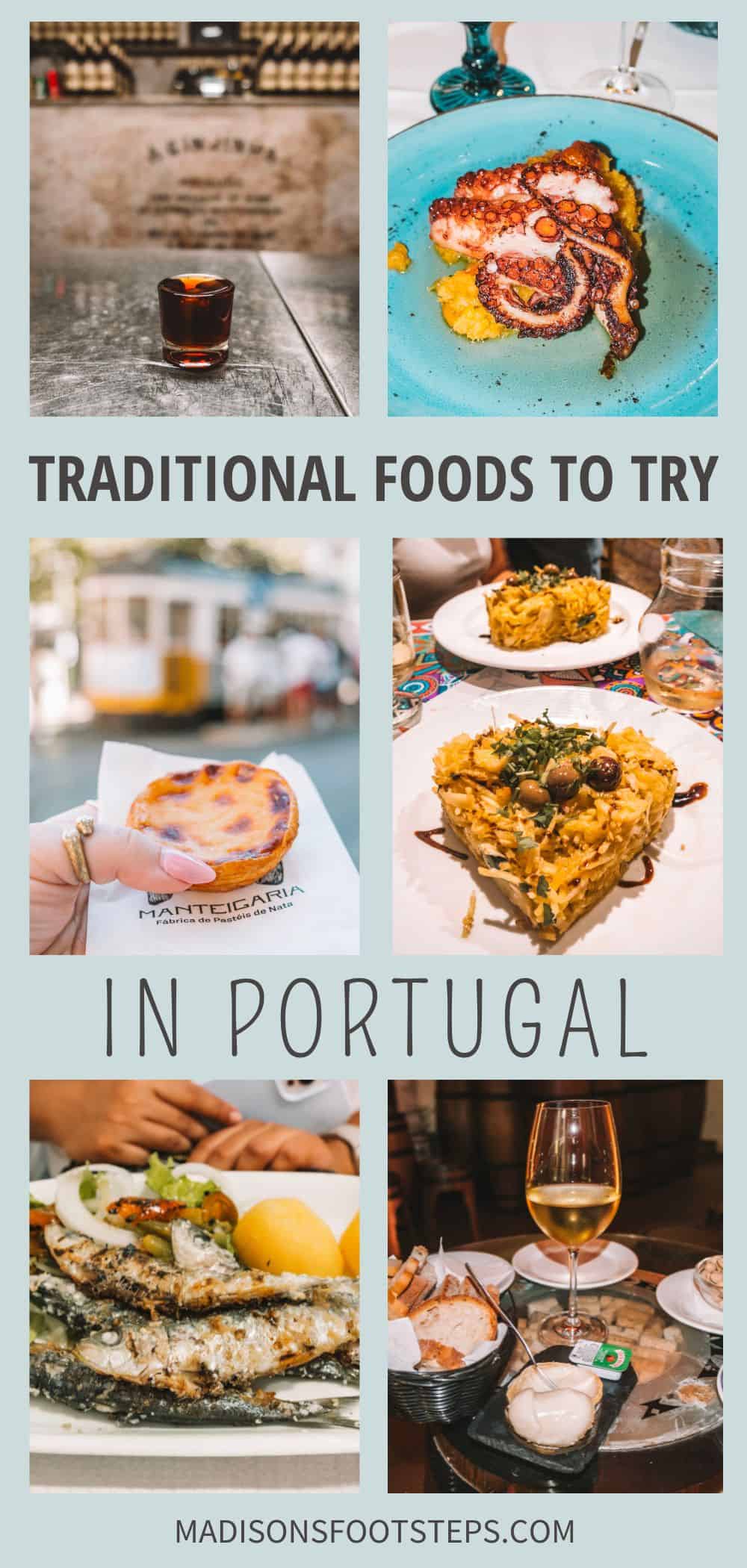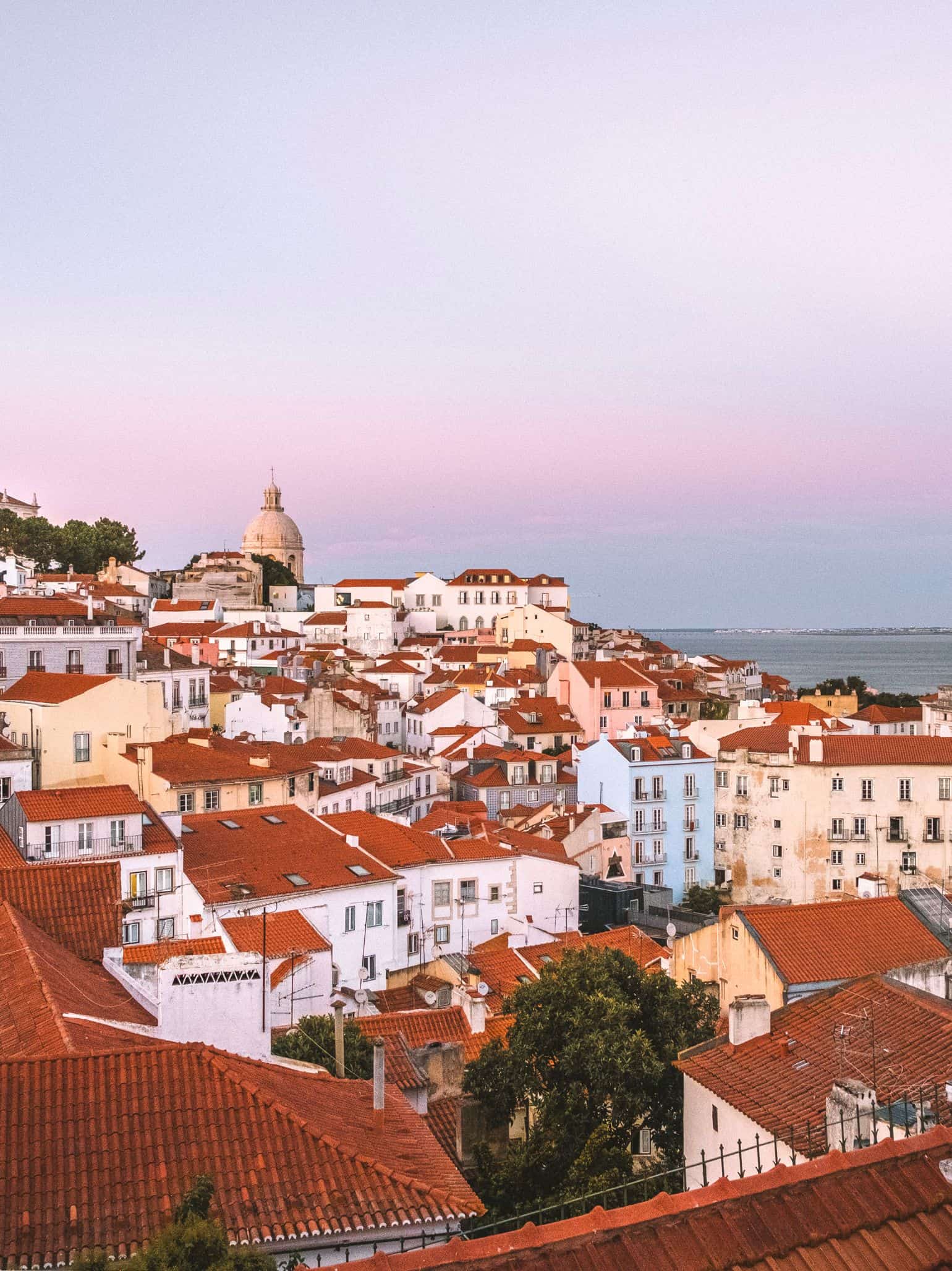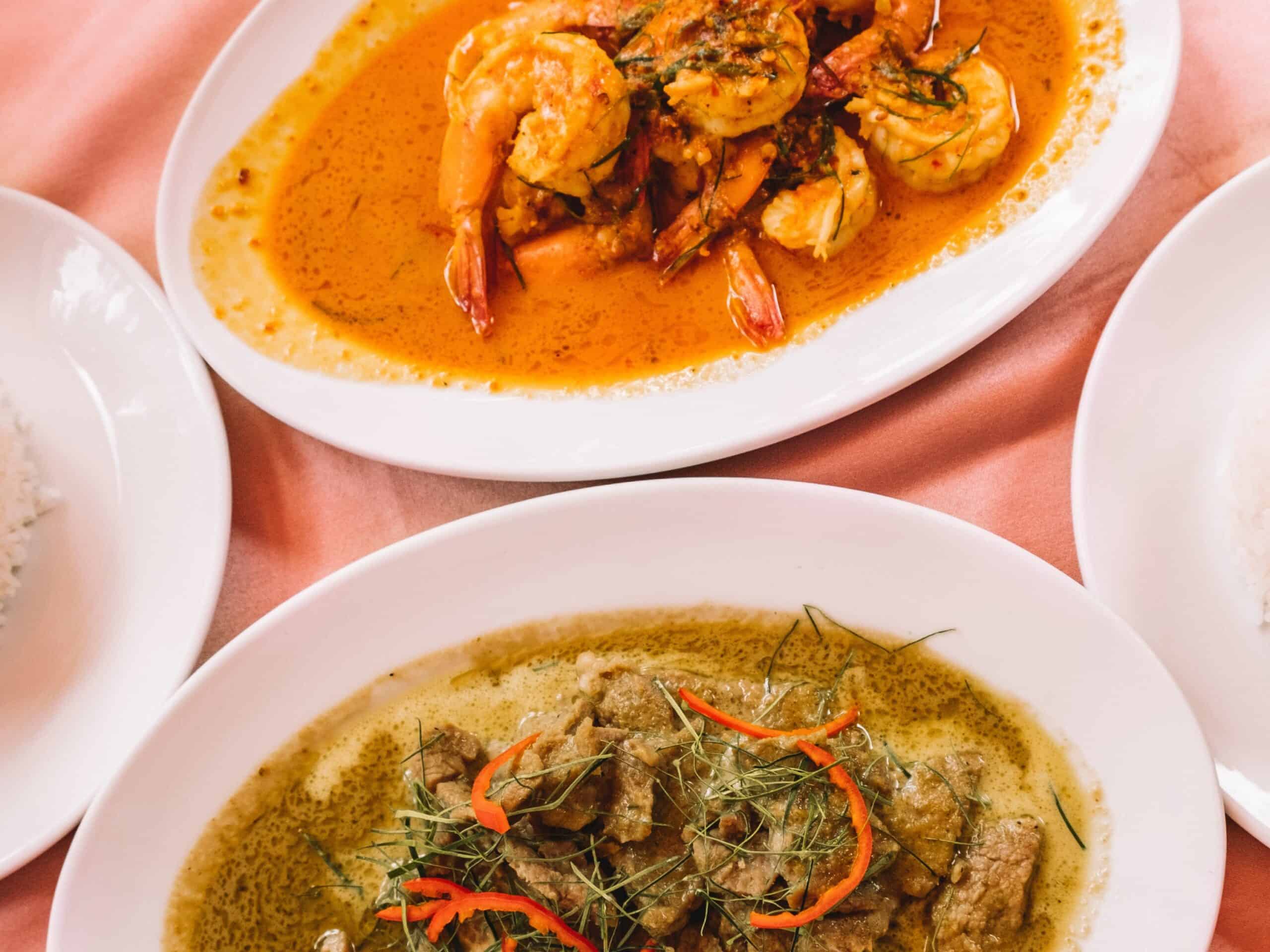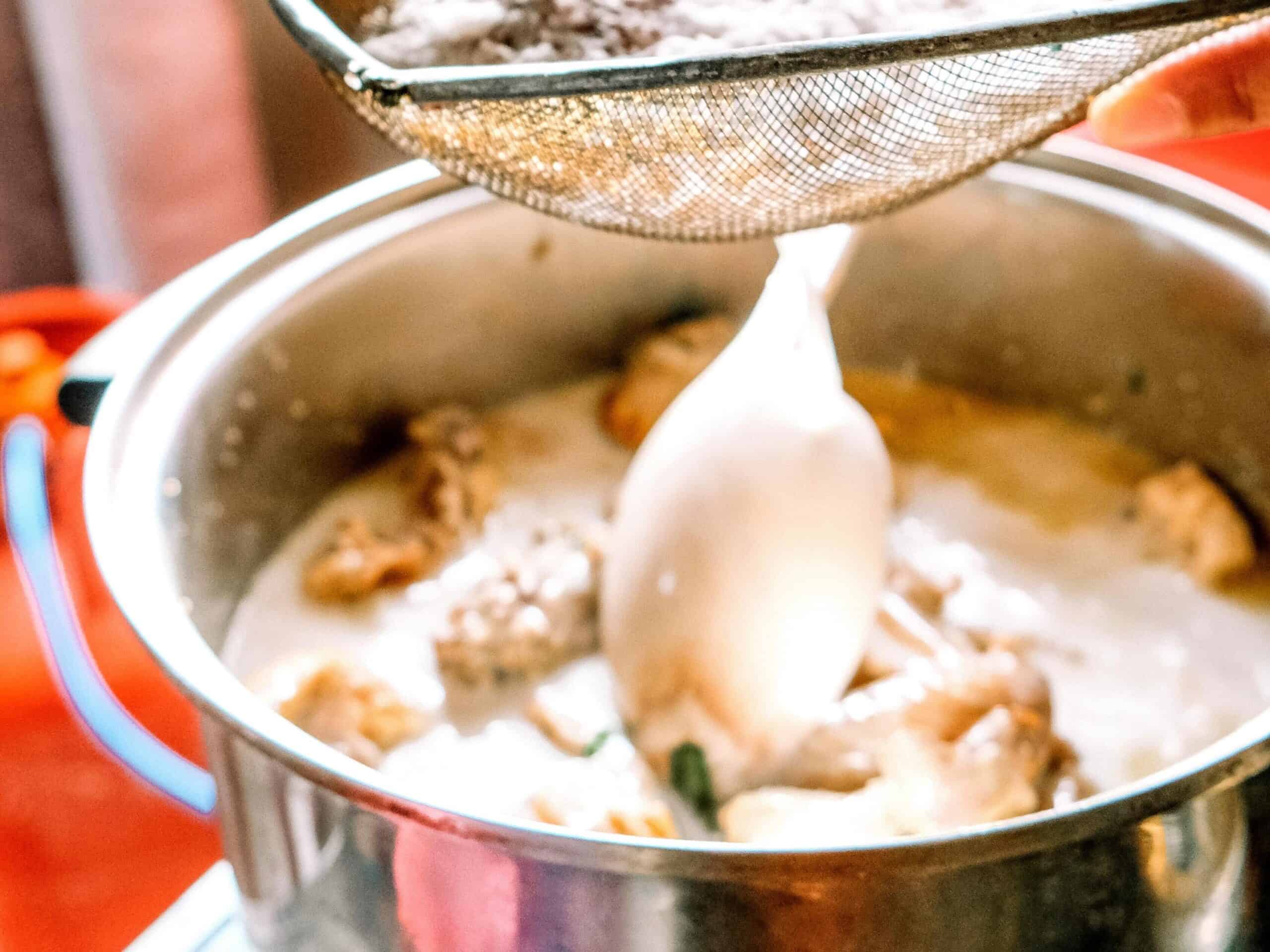29 Traditional Portuguese Foods to Try When Visiting Portugal
If you’re a foodie at heart, you’re not going to want to miss this virtual tour of the best traditional Portuguese foods in Portugal. From flaky and sweet pasteis de nata, to melt-in-your-mouth polvo a lagareiro—you’re guaranteed to fall in love with Portuguese cuisine by the end of this post.
Who loves food? 🙋🏽♀️ Whether it’s cacio e pepe in Italy, panang curry in Thailand, freshly made pierogi in Poland, or a hearty baleada in Honduras—I love trying new foods around the world. Thankfully for me during my two months in Lisbon, traditional Portuguese foods are some of the tastiest I’ve tried around the world.
If you love fresh seafood, impeccably seasoned meats, hearty soups, and flaky desserts, Portugal needs to be high on your foodie bucket list. Seriously—this country has it all. Cheese, bread, wine, seafood, you name it, and Portugal’s serving it.
I spent two months living in Lisbon in fall of 2023. During that time, we traveled to other popular destinations in the country, like Lagos, Madeira, Porto, and Sintra. In each new Portuguese destination, there was exciting and delicious new cuisine to try around every corner. I made it my mission to try it all! If you’re planning a trip to Portugal, or maybe you’re just excited about new international cuisine, you’re not going to want to miss these traditional Portuguese dishes.
Hope you’re hungry!


The Lazy Girl’s Guide to Portuguese Cuisine
If you don’t have time to read through my extensive list of famous food in Portugal, don’t sweat it. Grab the highlights below!
- FOR SEAFOOD LOVERS: Polvo a Lagareiro 🐙 (octopus in olive oil)
- FOR PICKY EATERS: Frango 🍗 (grilled chicken)
- FOR A SWEET TOOTH: Pasteis de Nata 🥚 (egg custard tart)
- FOR CARNIVORES: Chouriço à Bombeiro 🔥 (flaming chorizo)
- FOR CHEESE LOVERS: Francesinha 🥪
- THE ONE YOU CAN’T MISS: Bacalhau 🐟 (codfish—the national food of Portugal)
The Best Traditional Portuguese Foods
Did you know that Portugal played a huge role in food globalization? As early as the 13th-century Portugal began exploration and colonization efforts around the globe. They brought back spices from the East Indies, rice and tea from Asia, coffee and peanuts from Africa, and crops like potatoes and peppers from America.
As a result, Portuguese food traditions are really a mixture of flavors from all corners of the globe…all heavily influenced by the Mediterranean diet of course. The variety of Portuguese cuisine ensures that even the pickiest eaters will find something to fill their bellies in this jewel of the Iberian Peninsula. So pack some stretchy pants and let’s get started on our virtual tour of authentic Portuguese cuisine.
1. Bacalhau (Cod)
Cod, or as the Portuguese say, bacalhau, is not just a fish; it’s a national obsession. Portugal’s affinity for cod goes back centuries, stemming from the Age of Discoveries when Portuguese sailors reached Newfoundland and first encountered this chunky fish. The sailors cured the cod with salt to preserve it on long voyages to Asia and the Americas.
From the rich and creamy “bacalhau à brás”—which combines shredded cod with onions, fried potatoes, and eggs, to the delightful “bolinhos de bacalhau”—crispy codfish cakes that make the perfect starter, to the simplicity of salted cod, the versatility of cod in Portuguese cuisine is truly astounding.
During my self-led foodie tour of Lisbon, I found myself dining at Lisboa Tu e Eu 2, a quaint restaurant tucked into an alley only a stone’s throw from the historic Praça do Comércio. Here, my new walking tour friends and I (plus a random French guy we met in line) dined on some of the best “bacalhau à brás” I had tasted during my entire two months in Portugal. It’s also served in the shape of a heart!
If you only try one of these traditional Portuguese foods—I urge you to make it cod.
📍 Where to Try Bacalhau:
- A Casa do Bacalhau (Lisbon)
- Lisboa Tu e Eu 2 (Lisbon)
- O Caldo Verde (Lisbon)
- ComTradições (Funchal, Madeira)
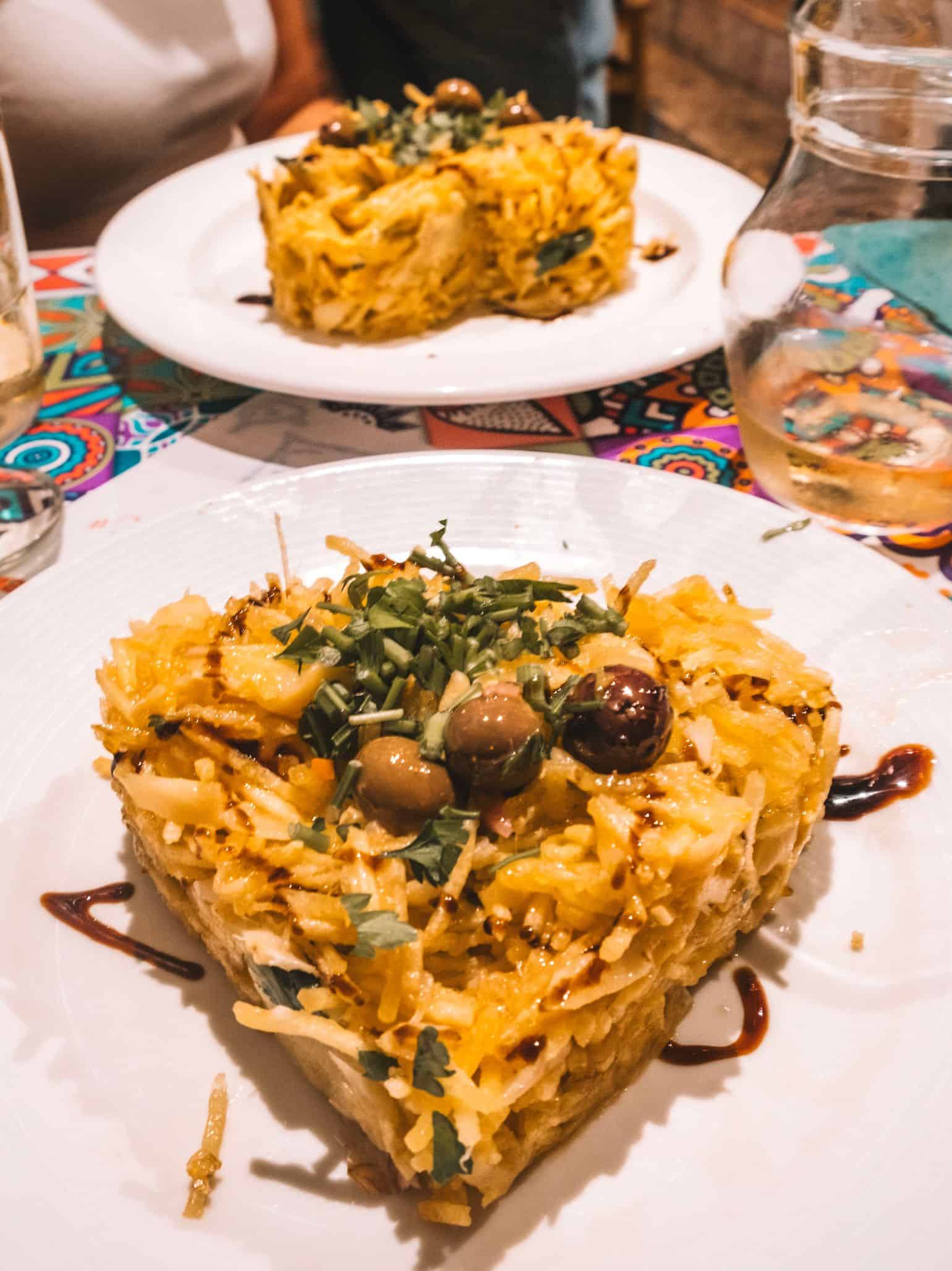
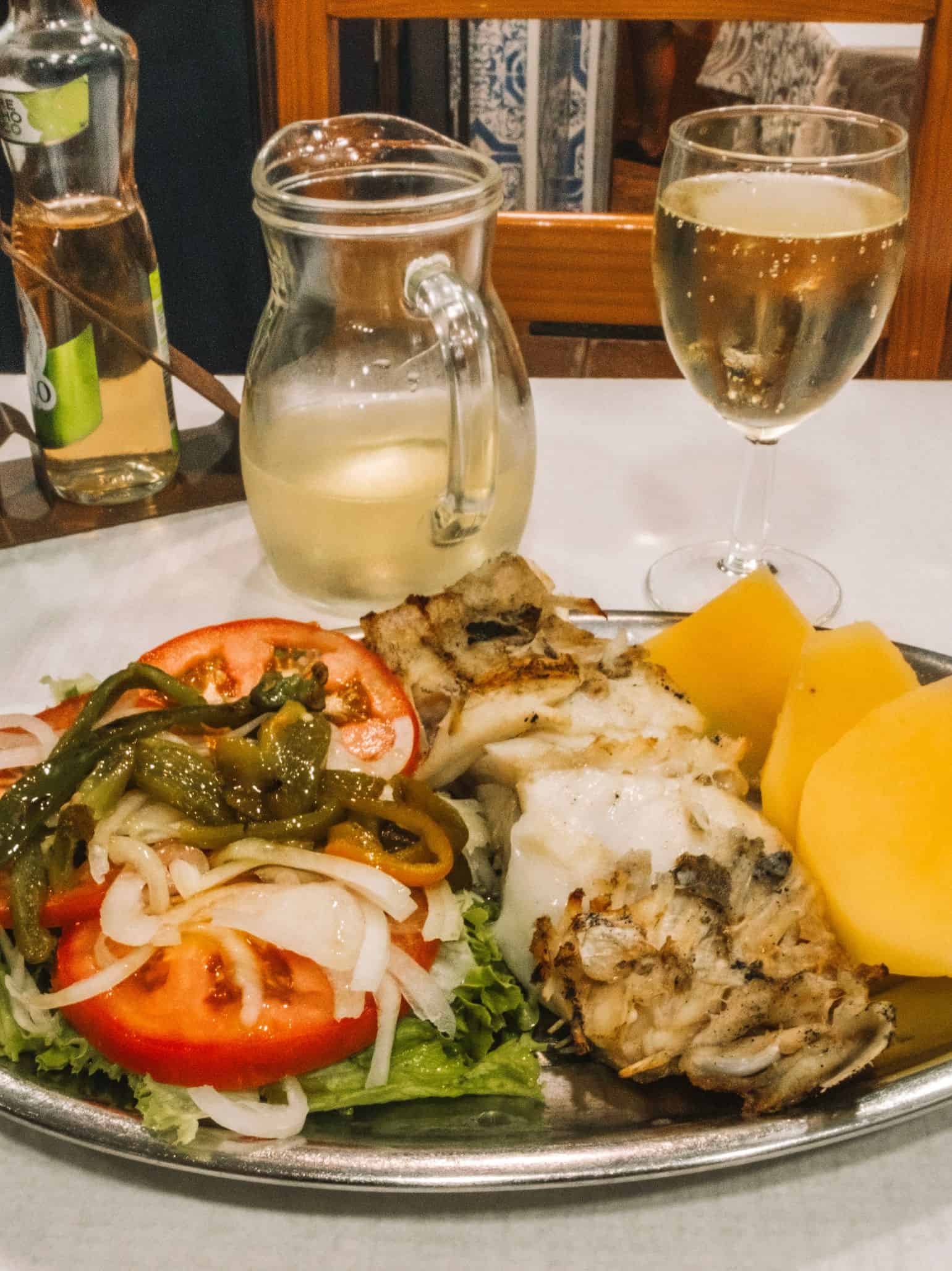
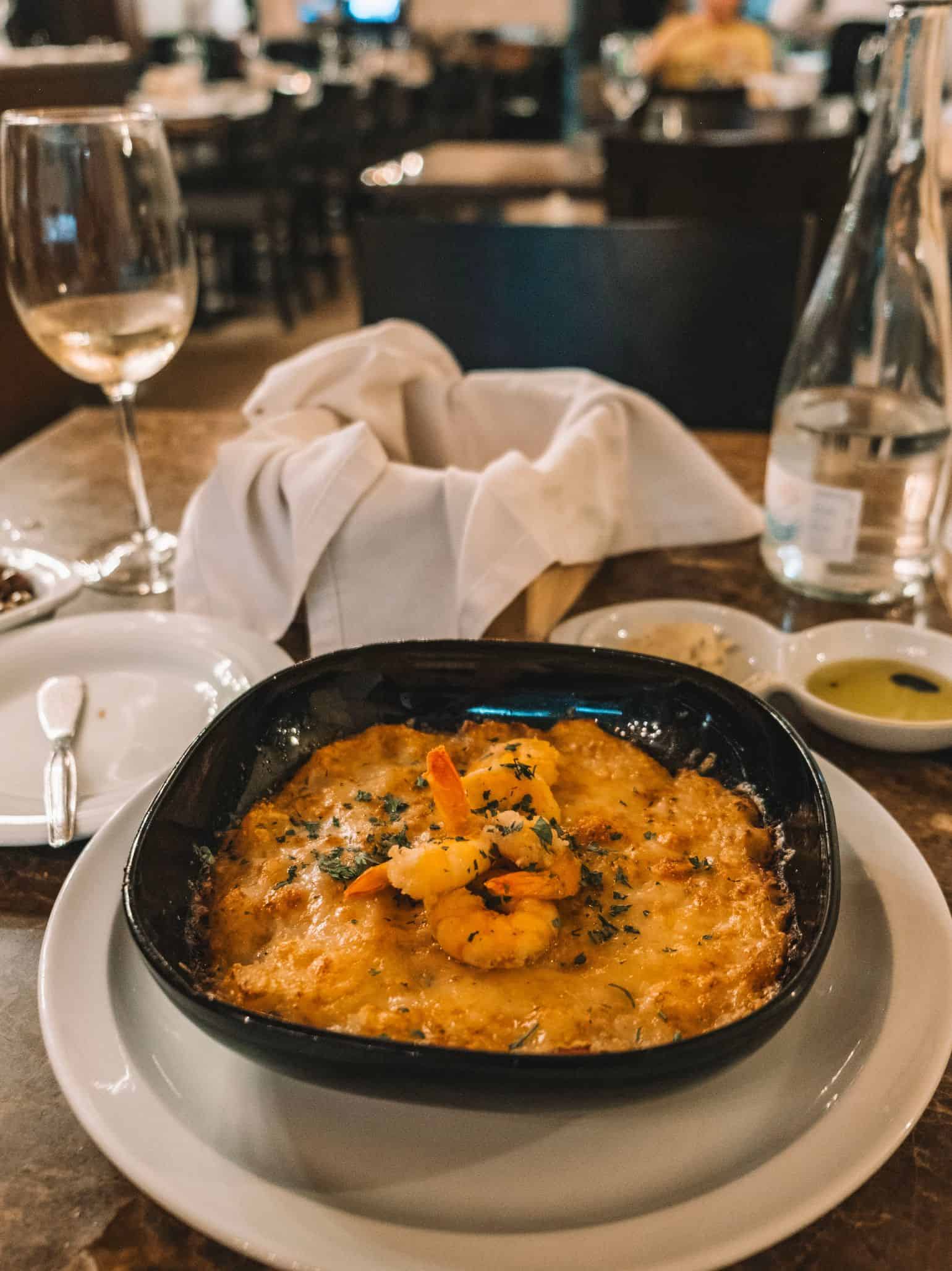
2. Bifanas (Portuguese Pork Sandwich)
The bifana, a seemingly humble yet absolutely irresistible component of Portuguese cuisine, has remained a favorite among both locals and travelers (and me!). While the exact origins of the bifana are unknown, a small town in the region of Alentejo lays claim to inventing this iconic sandwich. Featuring tender slices of pork marinated in a white wine, garlic, and paprika concoction and tucked inside a fluffy roll, the bifana is one of the most iconic traditional Portuguese foods to try on your next trip.
The first bifana I tried was from the world-famous Time Out Market. Yes—it’s touristy, but a visit here is a must on any Lisbon itinerary. Although it was admittedly overpriced, it was low-key delicious and had me contemplating round two. My second bifana, from Solar da Madalena (pictured below), was a much more authentic experience. I feasted on this gigantic bifana (enough for two meals) and a glass of wine for only €5.50!
📍 Where to Try Bifana:
- Solar da Madalena (Lisbon)
- Bifanas do Afanso (Lisbon)
- O Trevo (Lisbon)
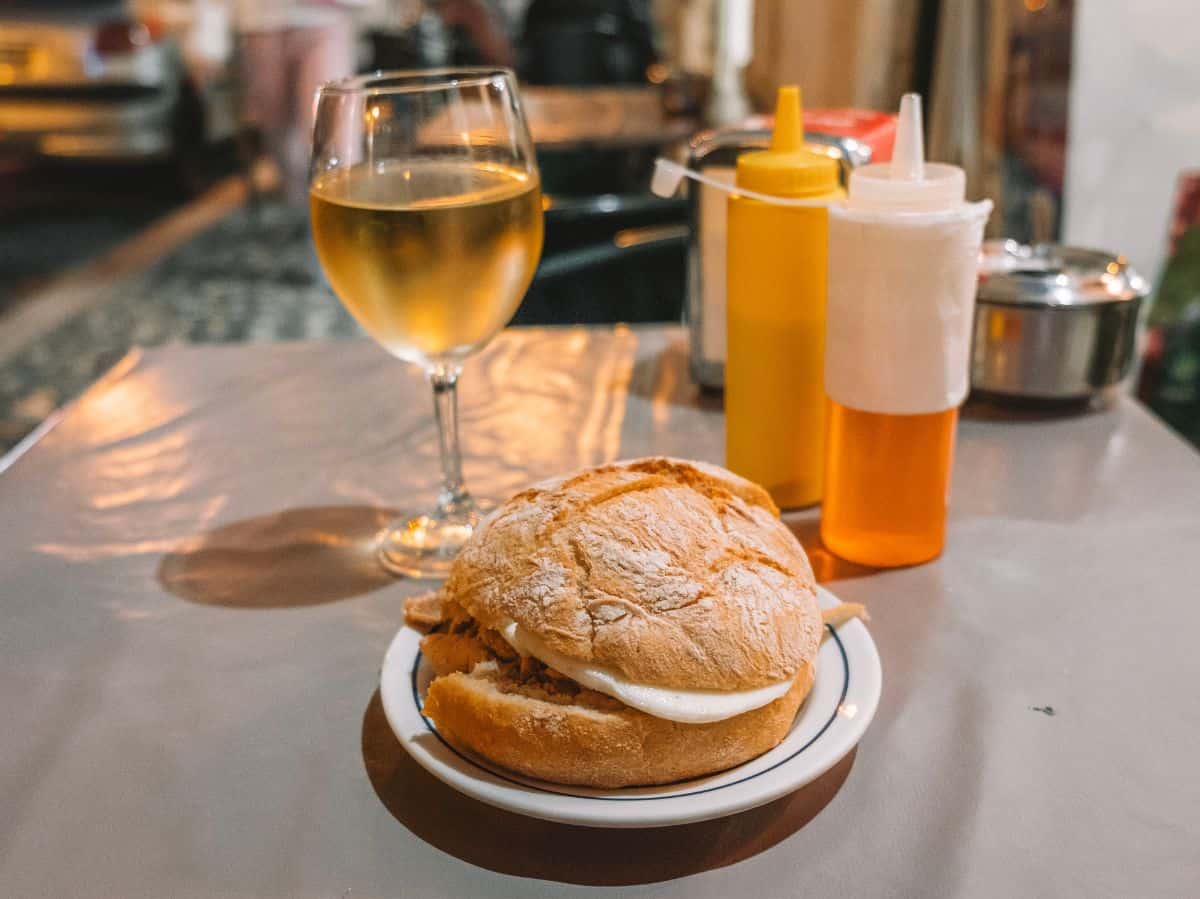
3. Arroz de Marisco (Seafood Rice)
If you’ve ever enjoyed savory paella on a trip to Spain, then you’re going to looooove this typical Portuguese food.
Arroz de marisco, or seafood rice, consists of a hearty bowl of rice filled with the freshest seafood you can imagine. BUT, don’t make the mistake of ordering “paella” at a Portuguese restaurant. There are distinct differences between the two dishes and the Portuguese don’t enjoy their yummy rice dish being confused with its Spanish counterpart. While paella consists of mostly dry rice and toppings, arroz de marisco is more on the soupy side (pictured below).
📍 Where to Try Arroz de Marisco:
- Penalva da Graca (Lisbon)
- Uma Marisqueira (Lisbon)
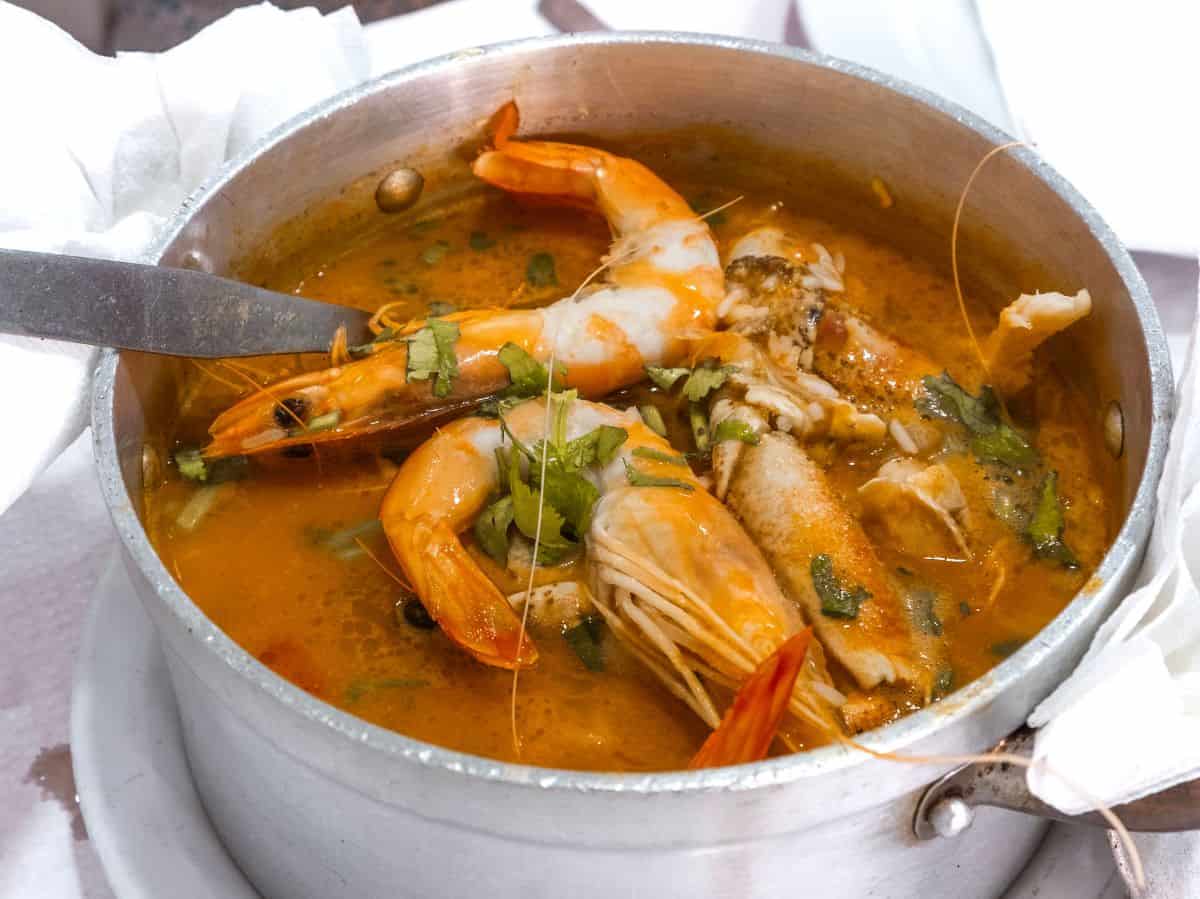
4. Sardinhas Assadas (Grilled Sardines)
The first thing you need to know about Portugal is that people here LOVE their sardines. Almost every restaurant serves a grilled version of these little salty fish and you’ll find canned sardine shops sprinkled throughout the city.
Being from the U.S., I know many (or honestly most) people I know back home would hard pass on a heaping plate of sardinhas…but I urge you to give them a chance when in Portugal. True, it’s a little difficult to eat around the bones, but once you actually taste the savory meat inside—you’ll be hooked.
📍 Where to Try Sardinhas:
- Penalva da Graca (Lisbon)
- Granja Velha (Lisbon)
- Casa dos Passarinhos (Lisbon)
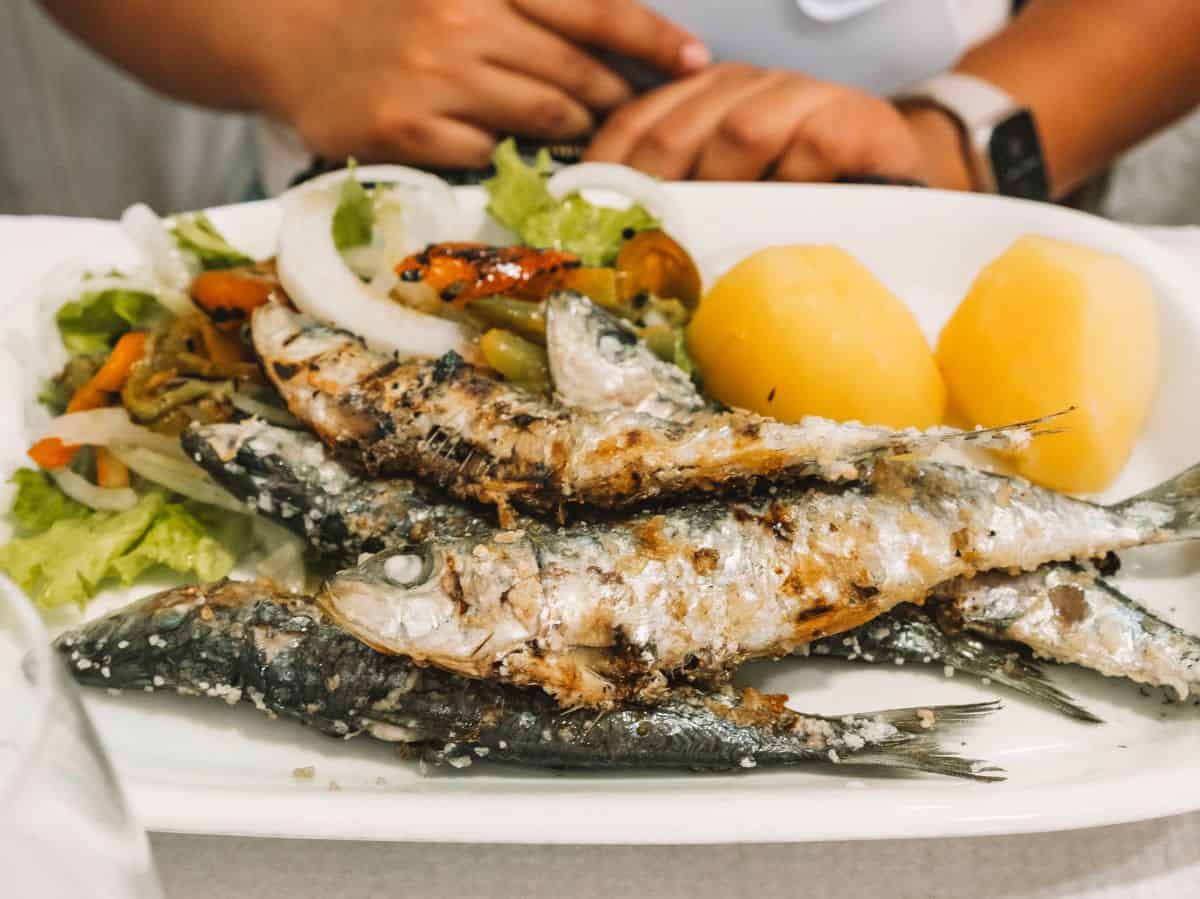
5. Cozido à Portuguesa (Mixed Meat Boil)
If I’m being honest, cozido à Portuguesa is not one of my favorite national dishes of Portugal, but it is one of the most historical.
This dish translates to mixed meat boil and consists of, you guessed it, boiled meat. Okay, I’ll admit it’s a little more than that. When ordering cozido à Portuguesa, your plate will be filled with slow-cooked meats (like chicken, pork ribs, bacon, etc.), sausages, and vegetables (typically turnips, cabbage, potatoes, etc.). It’s surprisingly quite healthy (minus the fatty meats), but it’s a bit dry for my taste.
📍 Where to Try Cozido à Portuguesa:
- Solar dos Presuntos (Lisbon)
- Adega Típica da Tala (Belas)
6. Carne de Porco à Portuguesa (Portuguese Style Pork)
Carne de porco à Portuguesa from A Padaria do Povo was actually my first meal when I moved back to Lisbon in August 2023. I asked the waiter what he recommended from the menu and he recommended this hearty dish full of crispy potatoes, savory pork, and fresh spices.
The more popular version of this dish is actually carne de porco à alentejana, which translates to “pork with clams” and can be found all over the country—specifically in the Algarve where it originated. This version includes fried potatoes, cubed pork, and fresh clams cooked in a white wine sauce… essentially Portugal’s version of surf n’ turf!
📍 Where to Try Carne de Porco à Portuguesa:
- A Padaria do Povo (Lisbon)
- Casa do Alentejo (Lisbon)
- Restaurante Fialho (Évora)
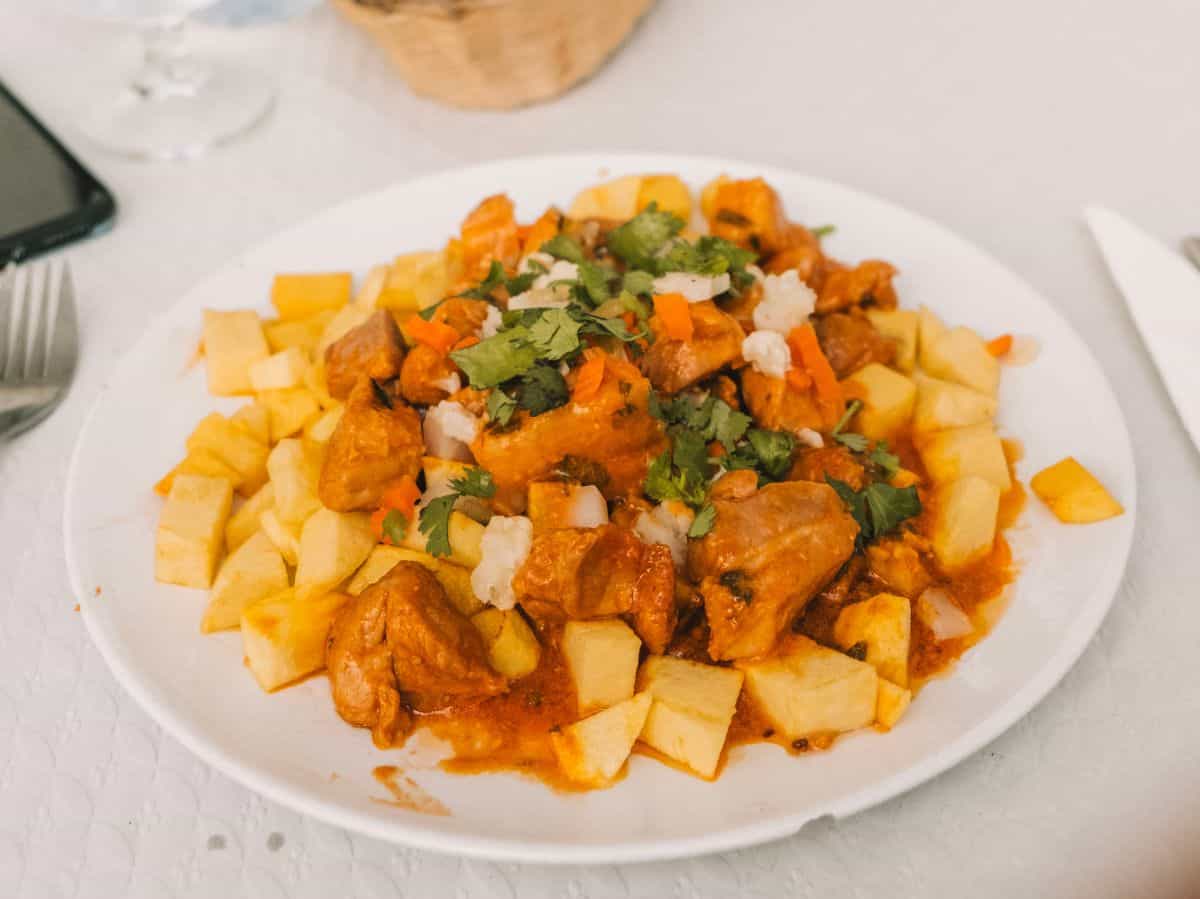
7. Bitoque (Steak with Egg)
Bitoque is a traditional Portuguese dish that consists of grilled or fried steak (sometimes pork) served with rice, french fries, and salad and topped with a runny fried egg.
You can find bitoque all over Portugal! It’s the perfect dish for when you’re craving some hearty protein—not to mention a great choice for picky eaters. My travel buddy is a steak connoisseur, so I had the chance to sample bitoque all across the country during my two months in Portugal.
📍 Where to Try Bitoque:
- Granja Velha (Lisbon)
- O Bitoque (Lisbon)
- Solar do Bitoque (Cascais)
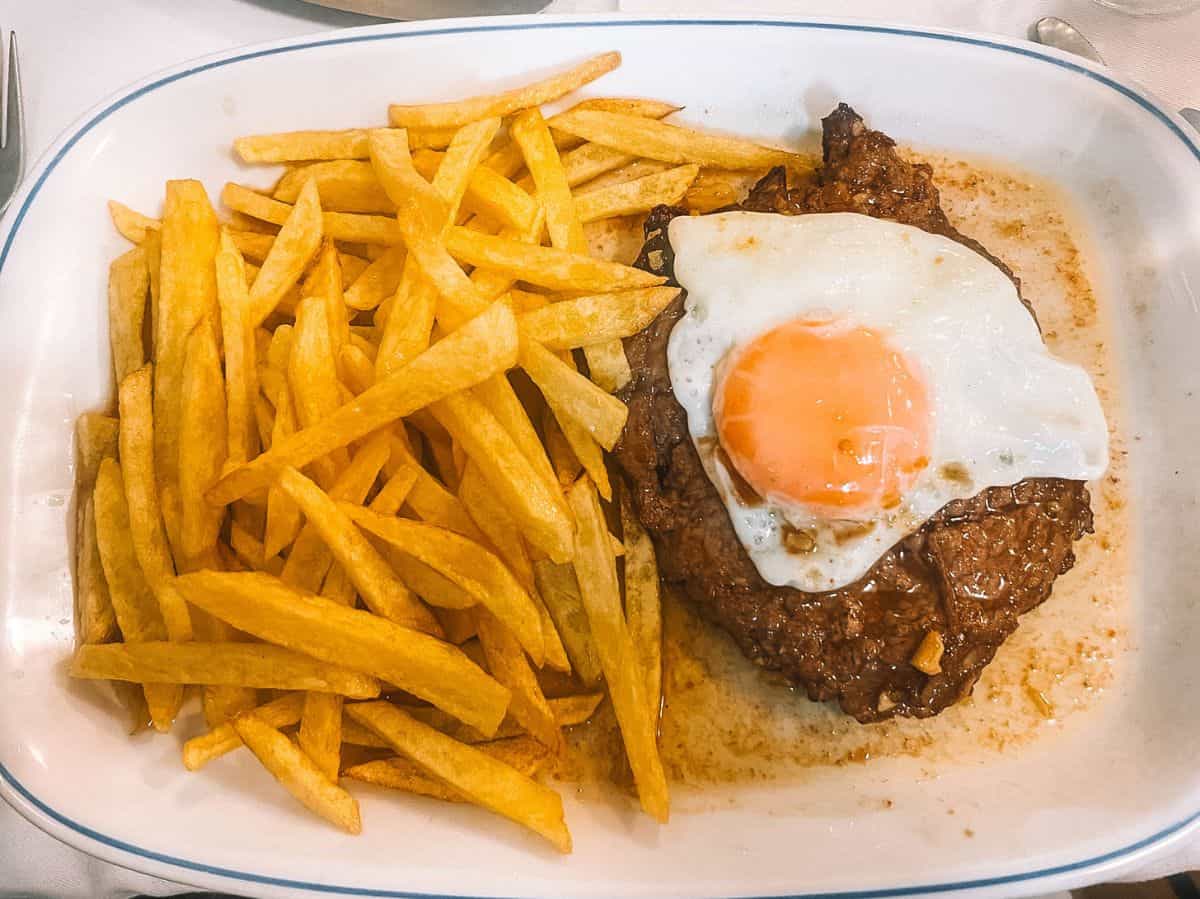
8. Porco Preto (Black Pork)
Black pork, or porco preto, from the Alentejo region is one of the most famous Portugal dishes…and one I unfortunately didn’t have the chance to try before I left. This special breed of pig, known as the Iberian pig, is native to the Iberian Peninsula and its meat is highly prized, not just in Portugal, but also across Spain.
Porco preto is served in many forms, but some of the most common include charcuterie, salami, and alongside clams in carne de porco à Alentejana. Its unique taste is often attributed to the pigs’ diet of acorns, which imparts a distinct quality to the meat, making it a sought-after delicacy in Portuguese cuisine.
📍 Where to Try Porco Preto:
- Taberna Típica Quarta Feira (Évora)
- Maca Verde (Lisbon)
9. Caldo Verde (Green Soup)
Originating in the Minho region of Northern Portugal, caldo verde has become a nationwide staple of Portuguese cuisine. Literally translating to “green soup,” this dish is made with potatoes, kale or collard greens, smoked sausage, and olive oil.
During my time living in Lisbon, I meandered across town to A Merendiera to try this famous Portuguese soup. Although I enjoyed the caldo verde, I was more impressed by this life-changing sourdough calzone stuffed with meat and cheese (pão com chouriço) that was served on the side (pictured below), and the vinho verde of course.
This entire meal from A Merendiera only set me back €5.50! It also happens to be a Lisbon favorite for drunk food before or after hitting the bars.
📍 Where to Try Caldo Verde:
- A Merendiera (Lisbon)
- Tasca do Chico (Lisbon)
- Casa da Horta (Porto)
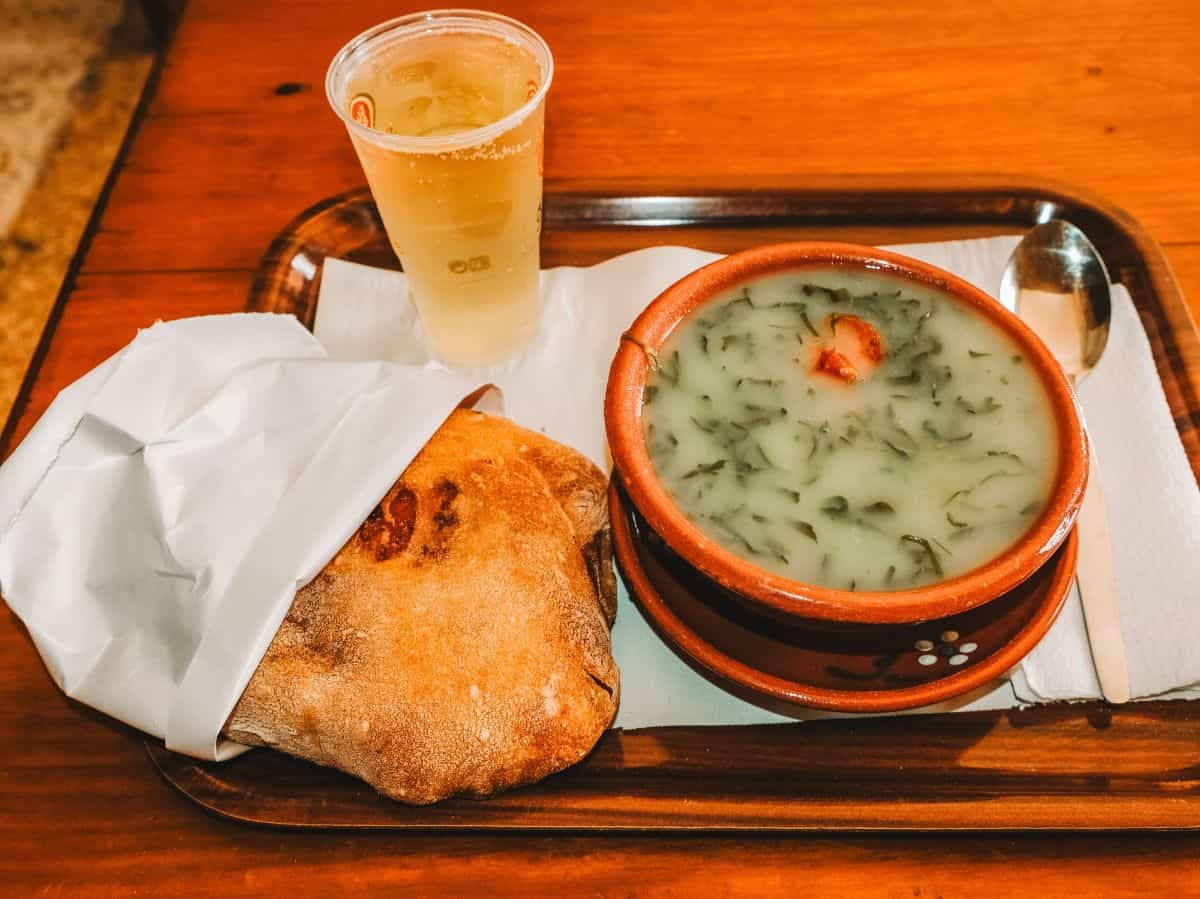
10. Polvo a Lagareiro (Octopus in Olive Oil)
No joke—this is one of my all-time FAVORITE dishes in the world.
Polvo a lagareiro, or octopus in olive oil, is a Portuguese favorite usually served with fingerling potatoes and salad. All I can say is that the Portuguese definitely know how to cook octopus—it’s so tender you can cut it with a spoon.
I tried this dish at Santo Andre in Alfama on my first trip to Lisbon back in 2019, and I’ve thought about it ever since. It was one of my first meals when I returned to Lisbon in 2023 and my last meal in the city before leaving for Rome. I highly recommend adding polvo a lagareiro to your list of traditional Portuguese foods!
Farol de Santa Luzia is another great spot to try polvo a lagareiro—just around the corner from the Miradouro de Santa Luzia in Alfama.
📍 Where to Try Polvo a Lagareiro:
- Santo Andre (Lisbon)
- Farol de Santa Luzia (Lisbon)
- Restaurante Abadia do Porto (Porto)
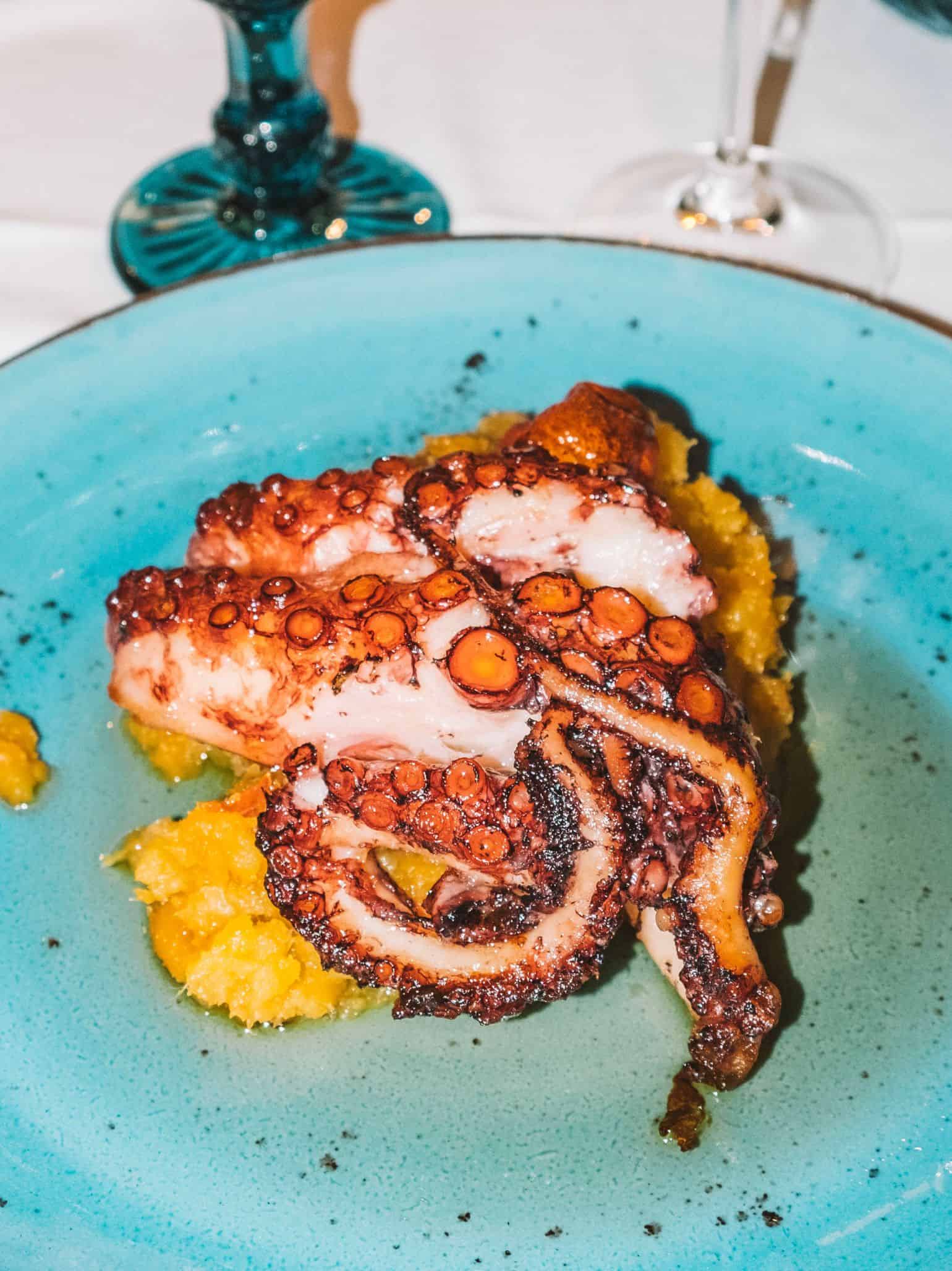

11. Queijo de Azeitao (Soft Cheese)
Queijo de Azeitao is a type of semi-soft cheese made from raw sheep’s milk that’s popular around Portugal (but originated in Azeitão). Long story short—this cheese is ridiculously delicious.
It’s served warm, with the top cut off—exposing the gooey, runny cheese inside the rind to be spread on bread or crackers. Let’s just say that whenever we bought this cheese…it didn’t last long.
Another famous traditional Portuguese cheese is Queijo da Serra da Estrela—a raw milk cheese made in the mountainous region of Serra da Estrela. The taste is absolutely delicious, and it’s a must-try for cheese lovers visiting Portugal.
📍 Where to Try Queijo de Azeitao:
- By the Wine (Lisbon)
- Manteigaria Silva (Lisbon)
- Mercado da Baixa (Lisbon)
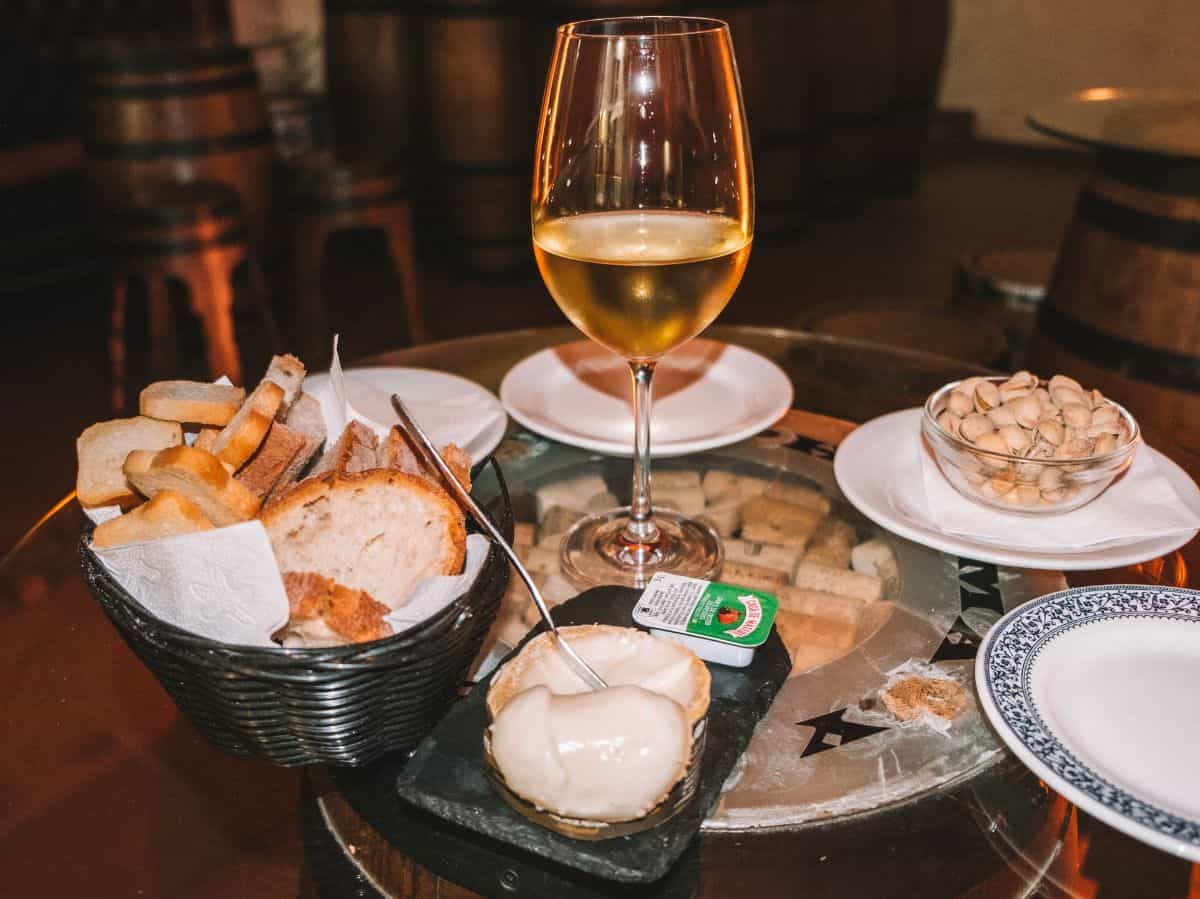
12. Ameijoas à Bulhão Pato (Clams with Vinho Verde)
Ameijoas à Bulhão Pato is a classic Portuguese seafood dish that originated in Lisbon. It consists of fresh clams cooked in white wine (usually vinho verde) with olive oil, garlic, and cilantro. The name “Bulhão Pato” refers to the Portuguese poet, Raimundo António de Bulhão Pato, who famously loved this dish!
This Portugal traditional food is usually served with bread to soak up the delicious broth. It’s a simple yet satisfying meal that perfectly captures the essence of Portuguese cuisine—fresh seafood, quality ingredients, and bold flavors.
📍 Where to Try Ameijoas à Bulhão Pato:
- Taberna da Rua das Flores (Lisbon)
- Porto Santa Maria (Cascais—Michelin Guide)
- Restaurante Casal da Penha (Funchal, Madeira—Michelin Guide)
- A Marisqueira de Matosinhos (Porto)
13. Pastel de Nata (Custard tart)
You can’t discuss famous Portuguese food without mentioning Portugal’s claim to fame—the pastel de nata. So what is it?
Pastéis de nata is a mouth-watering Portuguese custard tart that has gained international acclaim. This delectable pastry is made from a crisp, flaky puff pastry crust filled with a rich, creamy custard. The custard consists of egg yolks, sugar, milk, and a touch of vanilla, resulting in a silky smooth texture with a caramelized top. These tarts are often dusted with a sprinkle of cinnamon or powdered sugar before serving, adding an extra layer of YUM 😋
There are countless places to try pastéis de nata around Portugal, especially in Lisbon (like you needed another reason to visit Lisbon), but two of the most famous spots are Manteigaria (with locations around the city and in the Time Out Market) and Pastéis de Belém. I recommend trying both and judging which one was your favorite! (Although TBH…both of these sweet treats tasted almost the same to me.)
📍 Where to Try Pastéis de Nata:
- Manteigaria (Lisbon)
- Pastéis de Belém (Lisbon)
- Pastelaria Aloma (Lisbon)
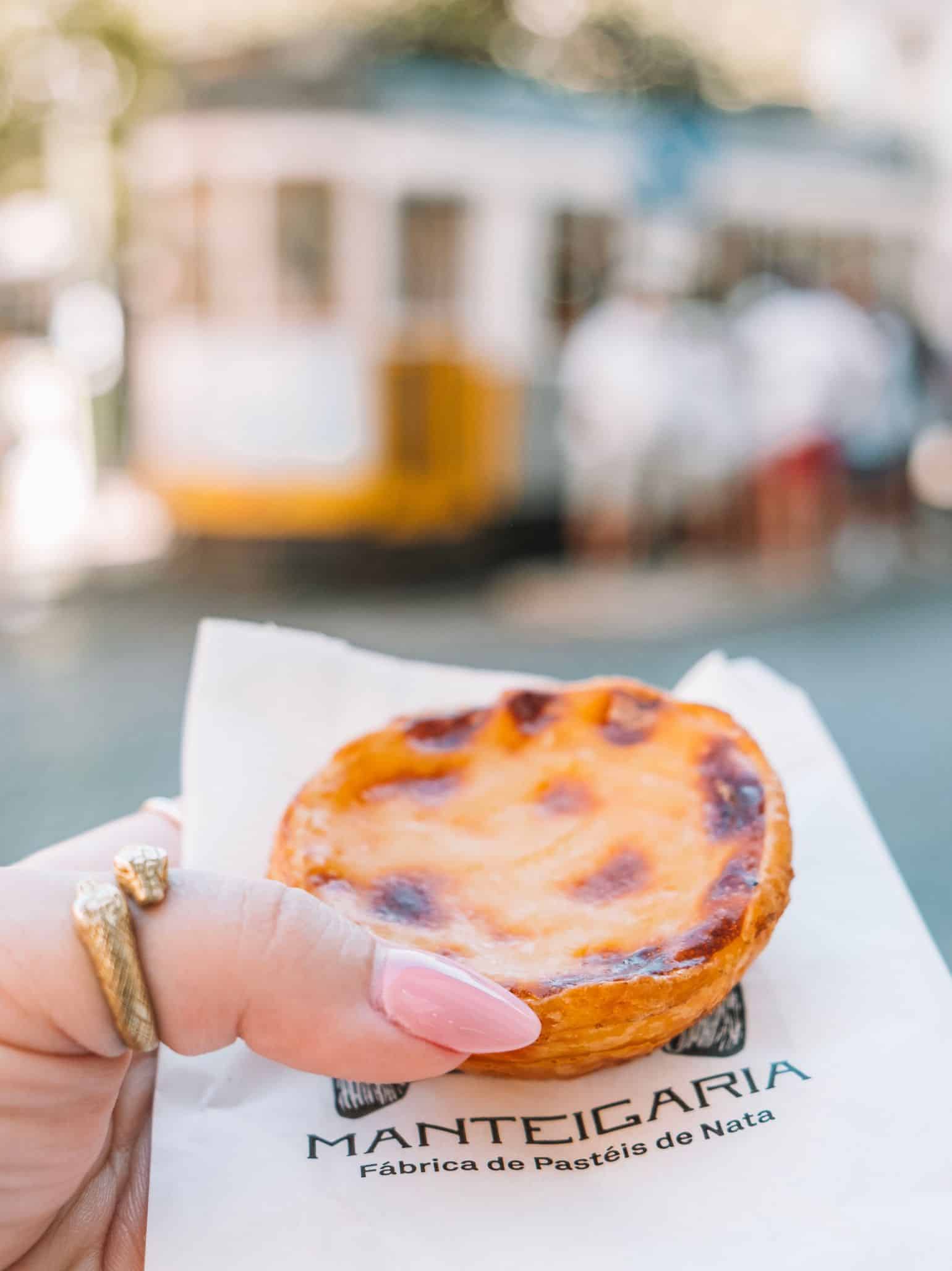
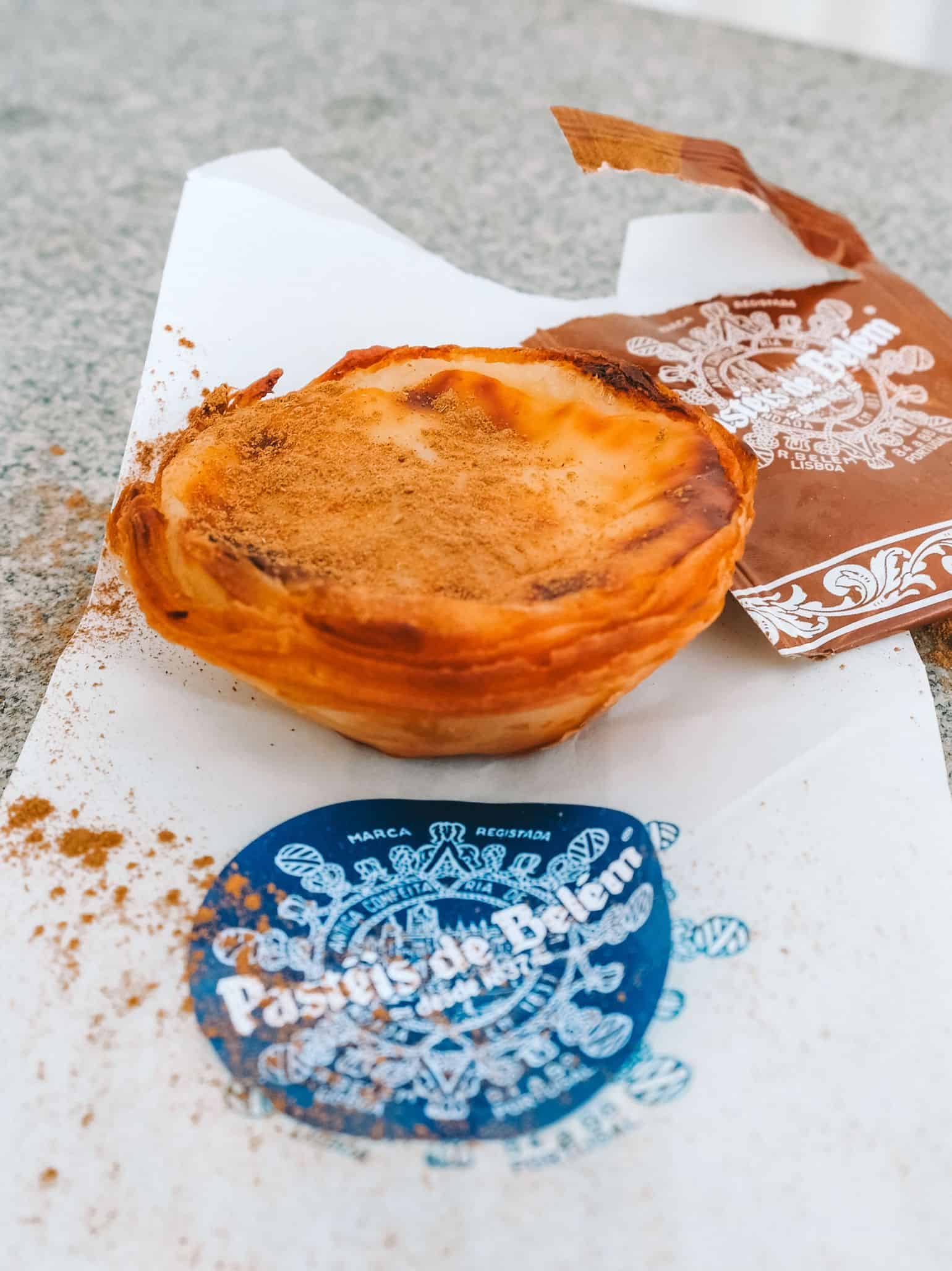
14. Prego (Garlicy Steak Sandwich)
If you believe “the limit does not exist” when it comes to garlic, then definitely don’t leave Portugal without trying prego—a delicious Portuguese meal consisting of tender beef seasoned with lots of garlic inside a crusty bread roll. Sometimes a bit of mustard or a fried egg is added for a tasty variation on the traditional recipe.
When I say it’s seasoned with lots of garlic, I mean it’s seasoned with lots of garlic. I found entire garlic cloves in my prego from Rui dos Pregos, and I couldn’t have been more delighted. Just maybe try and brush your teeth afterward.
📍 Where to Try Prego:
- Rui dos Pregos—Docas (Lisbon)
- Cervejaria Ramiro (Lisbon)
- O Prego (Lisbon)
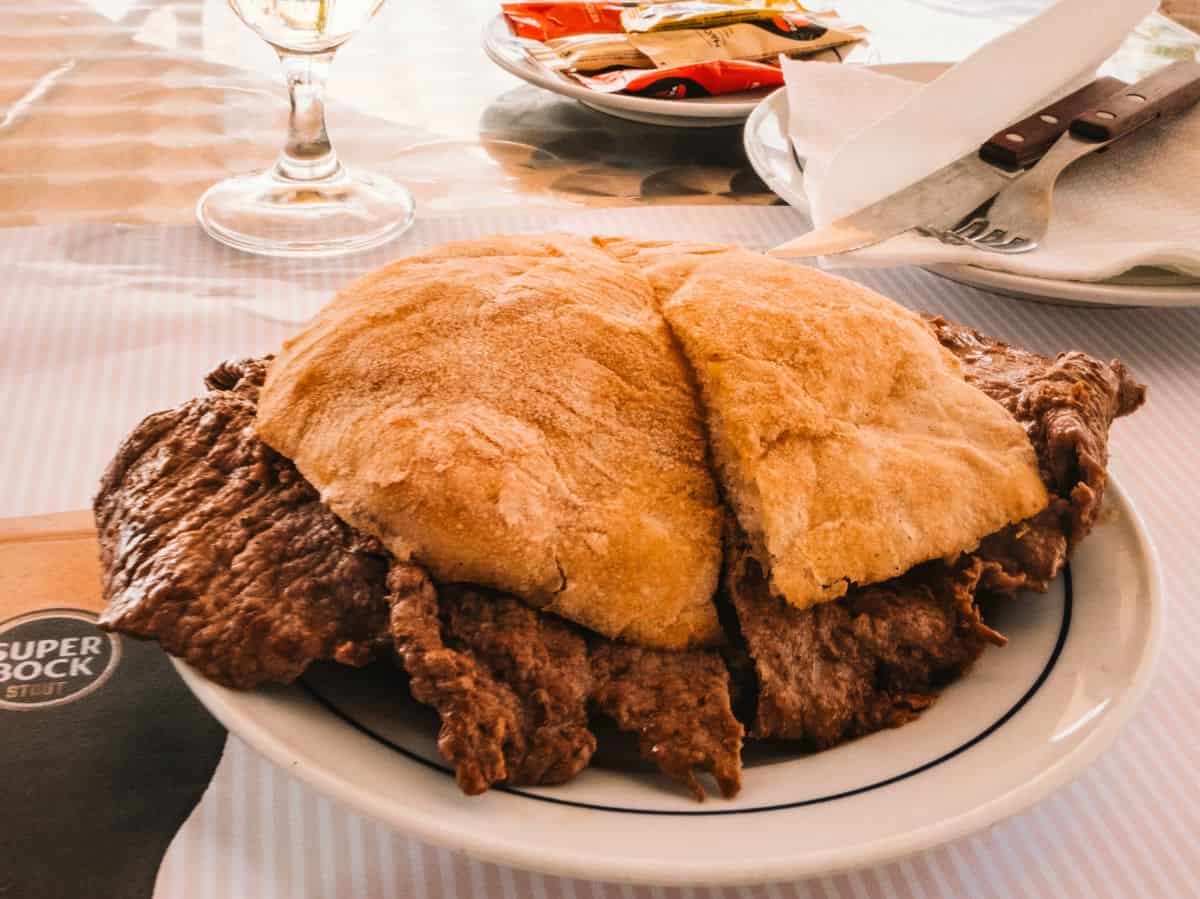
15. Frango Piri-Piri (Grilled Chicken with spicy sauce)
I tried frango for the first time at Restaurante Bonjardim in Lisbon, and let me tell you, it completely blew me away. Frango, or grilled chicken, is one of Portugal’s most beloved dishes, and it’s easy to see why. The chicken is typically marinated in a mixture of olive oil, garlic, lemon, white wine, and a variety of spices, then grilled over hot coals to perfection. The result is a juicy, tender, and incredibly flavorful meal that leaves you craving more. At Bonjardim, they serve it with a bit of piri piri sauce on top, which adds just the right amount of spicy kick (which you know I love). It’s also served with a mountain of french fries, so there’s really no chance of you going home hungry.
If you love simple but flavorful cooking—be sure to add frango to your list of traditional Portuguese foods to try in Portugal.
📍 Where to Try Frango:
- Restaurante Bonjardim (Lisbon)
- Ramires (Guia)
- Churrasqueira Guerreiro (Portimão)
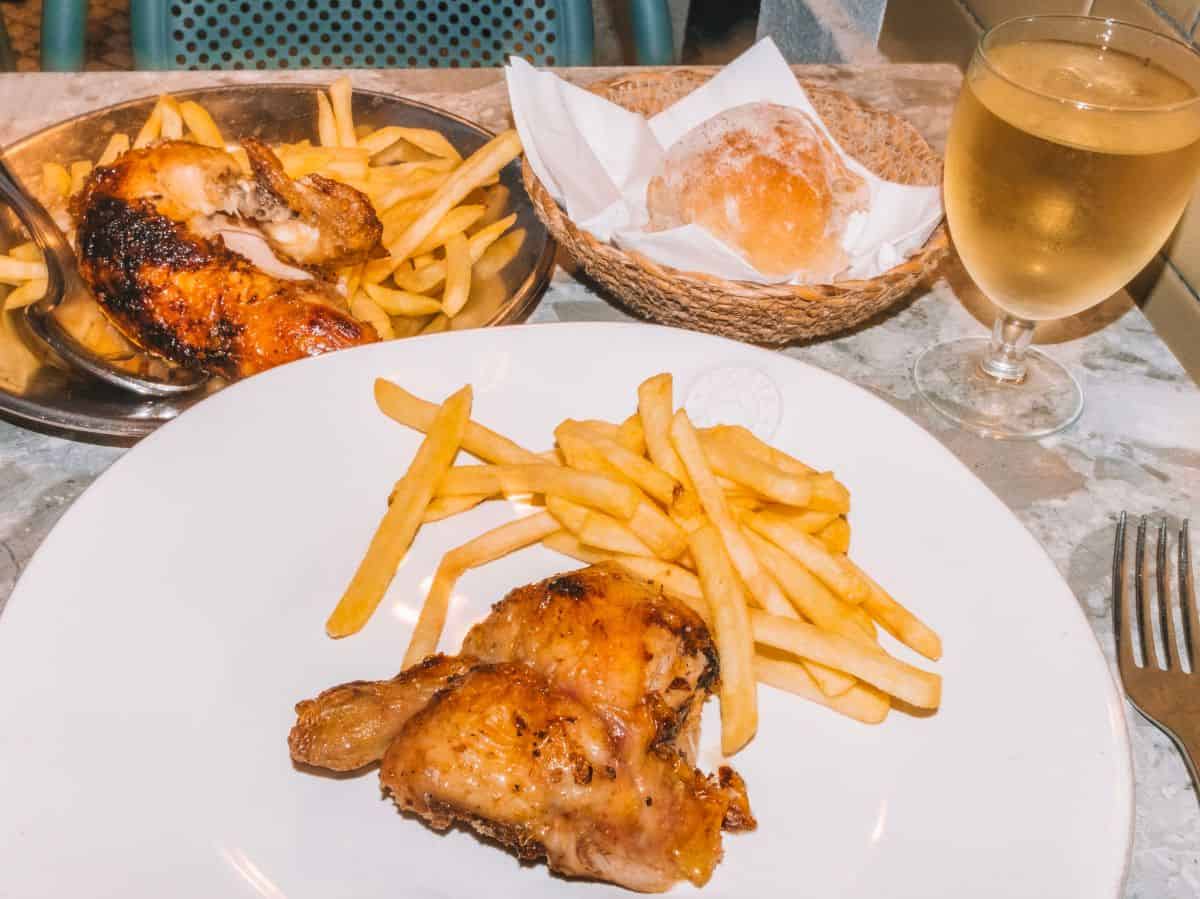
16. Ginjinha (Cherry Liquor)
Ginjinha, also known simply as ginja, is a traditional Portuguese cherry liquor that has a rich history dating back to the 19th century. Legend says that the drink originated in Lisbon, thanks to a Galician friar named Francisco Espinheira. He is said to have experimented with the infusion of ginja berries (sour cherries) in aguardente (a type of Portuguese brandy), adding sugar, water, and cinnamon to create a delightful and aromatic drink.
In 2024, you can’t visit Portugal without trying ginja at least once during your trip. I always tell people to go to A Ginjinha—a tiny, but historic bar with standing room only that can trace its roots all the way back to 1840 and the invention of ginja.
As someone who can’t stand shots (besides the occasional Fireball), it really wasn’t bad. It’s not super strong, and the cherry/cinnamony flavor is pretty smooth going down.
📍 Where to Try Ginja:
- A Ginjinha Espinheira (Lisbon)
- Ginjinha Sem Rival (Lisbon)
- Ginja D’Alfama (Lisbon)

17. Alheira de Mirandela (Portuguese Sausage)
Alheira de Mirandela is a delicious Portuguese sausage with a fascinating history hailing from Mirandela—a mountainous town in Northern Portugal. In the 16th century, Portuguese Jews invented a new type of kosher sausage that looked like pork to hide their religion from the Spanish Inquisition.
I headed to Casa dos Passarinhos (arguably my favorite restaurant in Lisbon) to try this sausage for myself.
Made from bread crumbs, smoked and shredded chicken, garlic, and red wine vinegar, Alheira de Mirandela is usually served with french fries, a small salad, and a fried egg on top. My meal was delicious, but to be honest I was a lot more jealous of the woman next to me with a 2-inch thick raw steak cooking itself on a hot stone. I ordered that next time, and it was genuinely the best steak I’ve had since Trattoria 13 Gobbi in Florence 😍
Peep my all-time favorite sling bag from Calpak in the photo below. This thing fits everything, including my Canon R50, and is worn in front of your body so you never have to worry about pickpockets.
📍 Where to Try Alheira de Mirandela:
- Casa dos Passarinhos (Lisbon)
- Restaurante Carvalho (Chaves—Michelin Guide)
- Salsa & Coentros (Lisbon)
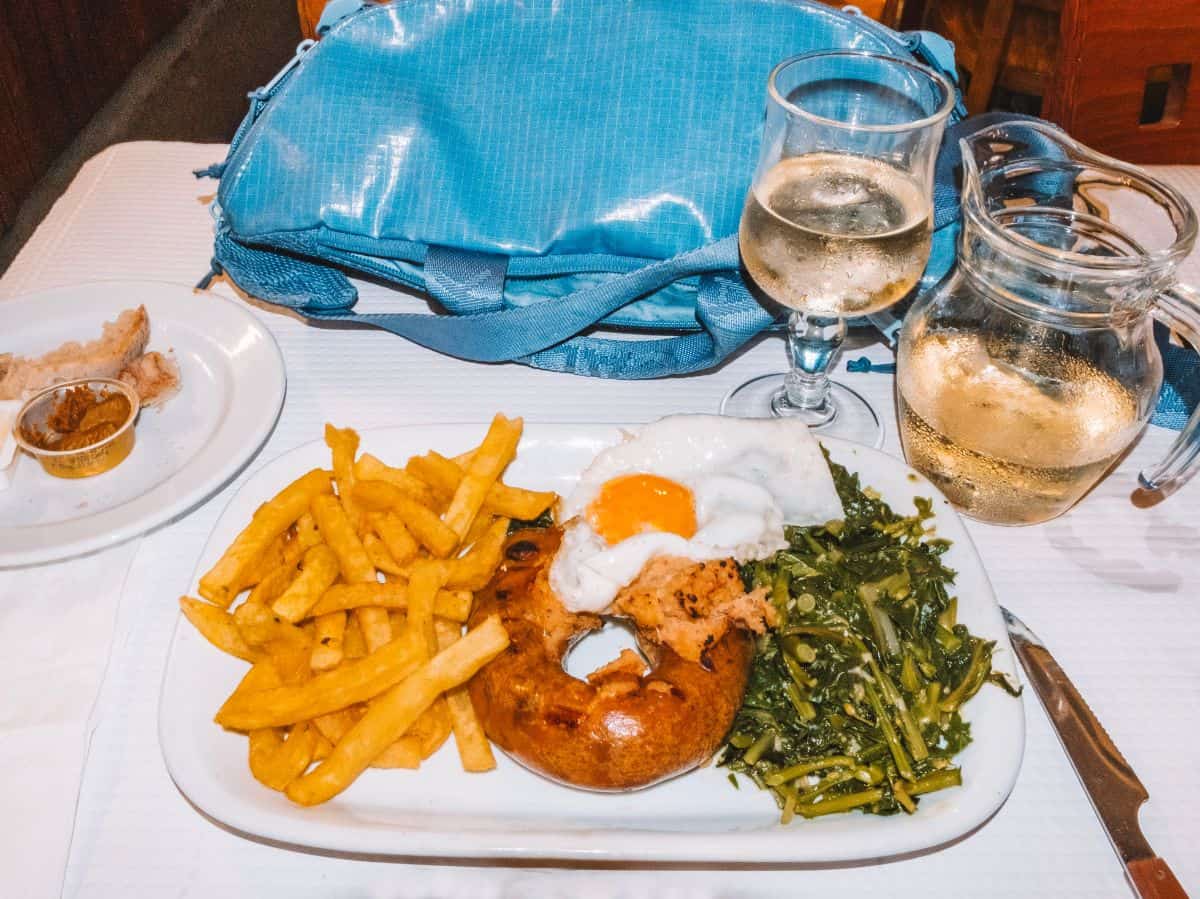
18. Cataplana de Mariscos (Seafood Stew)
Cataplana is undeniably one of the most famous Portuguese dishes and a true embodiment of the country’s rich maritime heritage. Originating from the Algarve region, this seafood stew is traditionally cooked in a domed, clam-shaped copper pot also called a “cataplana.” The unique cooking method ensures that all the tasty flavors—clams, prawns, fish—blend perfectly with the onions, garlic, bell peppers, and a splash of white wine.
Try it at one of the restaurants below on your next trip to Portugal!
📍 Where to Try Cataplana de Mariscos:
- Casinha do Petisco (Lagos)
- Aqui Há Peixe (Lisbon)
- Restaurante Porto Brandão (Caparica)
19. Vinho Verde (Green Wine)
When it comes to the list of traditional Portuguese foods and drinks, vinho verde is at the top of my list! Literally translating to “green wine,” no trip to Portugal is complete without consuming copious amounts of this tasty beverage that tastes like a mix between white wine and prosecco.
This delicious wine hails from the lush Minho region in the northwestern region of the country. The history of vinho verde dates back to Roman times, when the viticulture in this fertile region first began to develop. Over the centuries, local farmers and winemakers have refined their techniques, leading to the production of these light, crisp, and slightly fizzy wines that are highly cherished both in Portugal and internationally (especially by me and my friends in Portugal). Today, vinho verde is synonymous with the vibrant culture and rich wine-making history of the Minho region, making it both a staple in Portuguese wine heritage…and a staple in the Bairro Alto district for solo travelers looking to get their pub crawl on.
📍 Where to Try Vinho Verde:
- On a vinho verde tasting tour from Porto! (⭐️ 5/5)
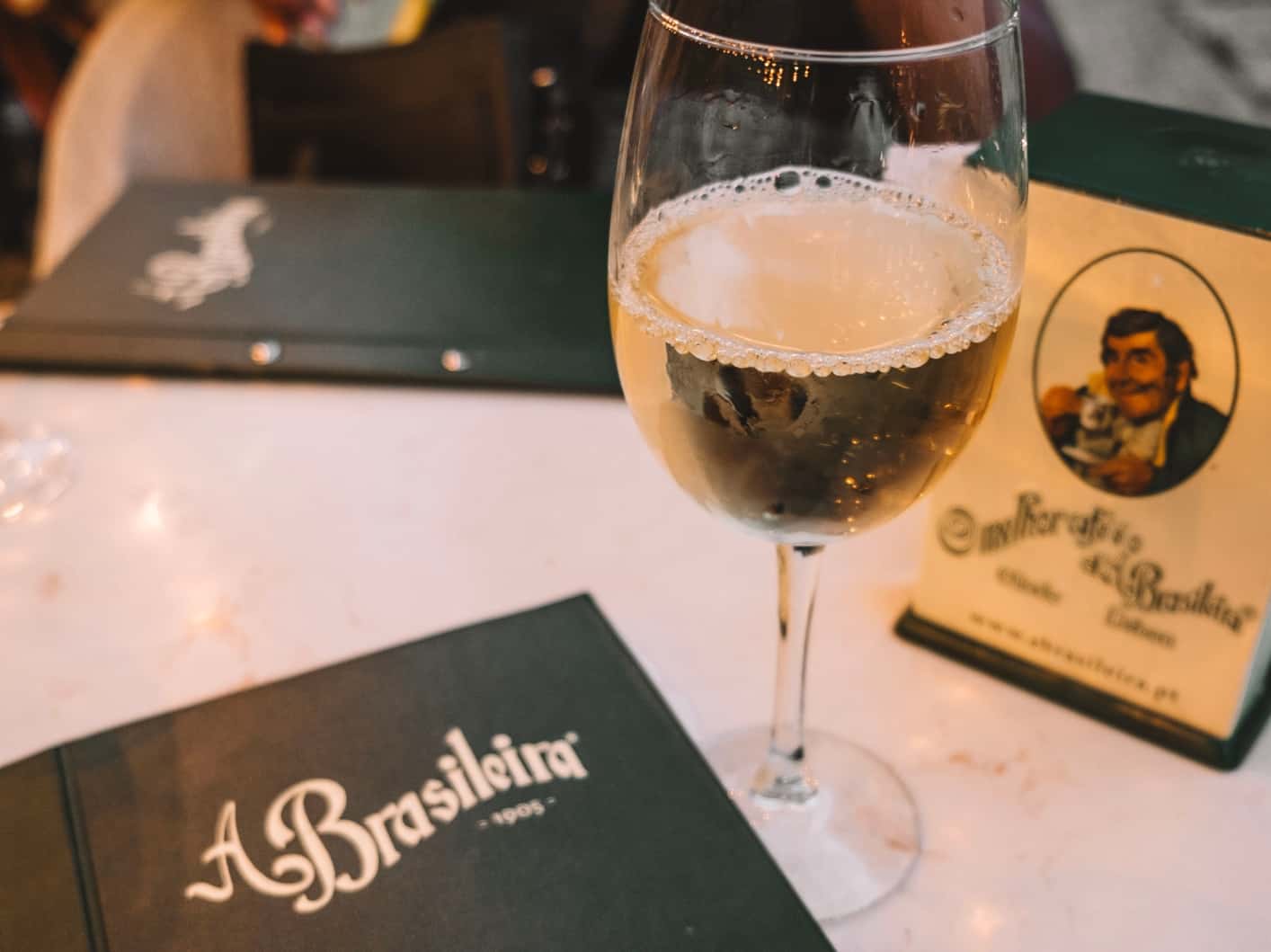
20. The Francesinha
Since the first day I arrived in Portugal, I wanted to try the world-famous Francesinha sandwich—arguably the most popular Portuguese food.
What I didn’t realize at the time is that the Francesinha hails from Porto…not Lisbon, where I had just moved. Rather than try a subpar version nearby, I decided to wait seven whole weeks until our trip to Porto for a bite of this legendary sandwich. When I finally tried it, I’m happy to say it did not disappoint.
Cut to my friend and I, super hungover in the Selina Hostel lobby, frantically Googling the best Francesinha sandwich shops in Porto. We quickly settled on O Afonso and headed over to soak up any leftover alcohol in our stomachs with french fries and lots of cheese.
The Francesinha was invented back in the 1960s and is a Portuguese take on the French croque-monsieur. The sandwich is layered with cured ham, fresh sausage, and steak or roast meat, and topped with melted cheese and a rich beer sauce (that can also be spicy). It’s not just a sandwich; it’s a comforting meal that captures the essence of traditional Portugal…and the perfect hangover cure rolled up in one tasty package.
📍 Where to Try Francesinha:
- O Afonso (Porto)
- O Golfinho (Porto)
- Lado B (Porto)
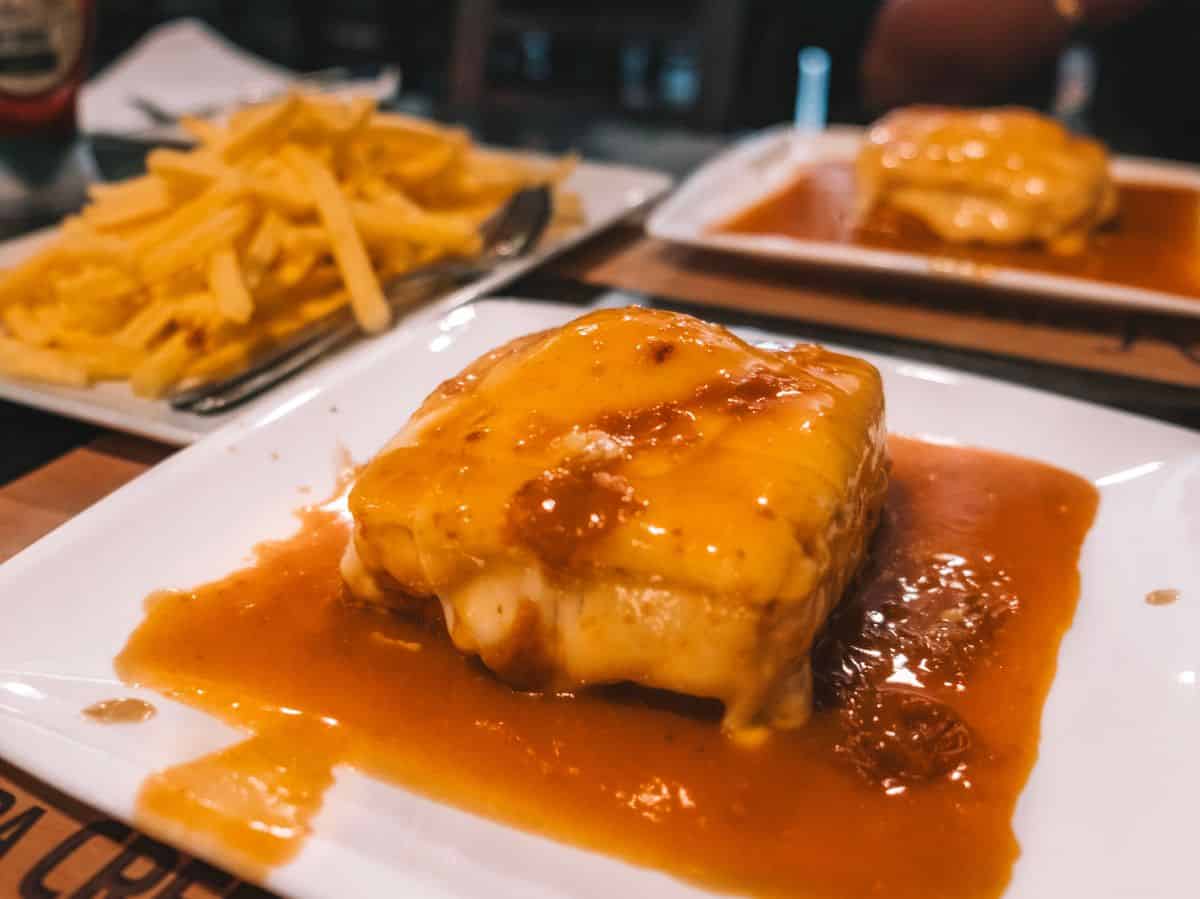
21. Lupini Beans
I discovered lupini beans at a little bar in Porto at the Miradouro do Passeio das Virtudes. We ordered a couple of vinho verdes and noticed that the bartender was scooping olives and little yellow beans into plastic cups for some of the other tables.
I asked to try the beans, paid my €0.50, and we scooted out to get a front-row spot for the sunset.
Lupini beans are crunchy, salty, and the perfect complement to a glass of light, fizzy wine. They’re a popular bar snack all around Portugal, so if you see some, be sure to grab a bowl.
📍 Where to Try Lupini Beans:
- Musa das Virtudes (Porto)
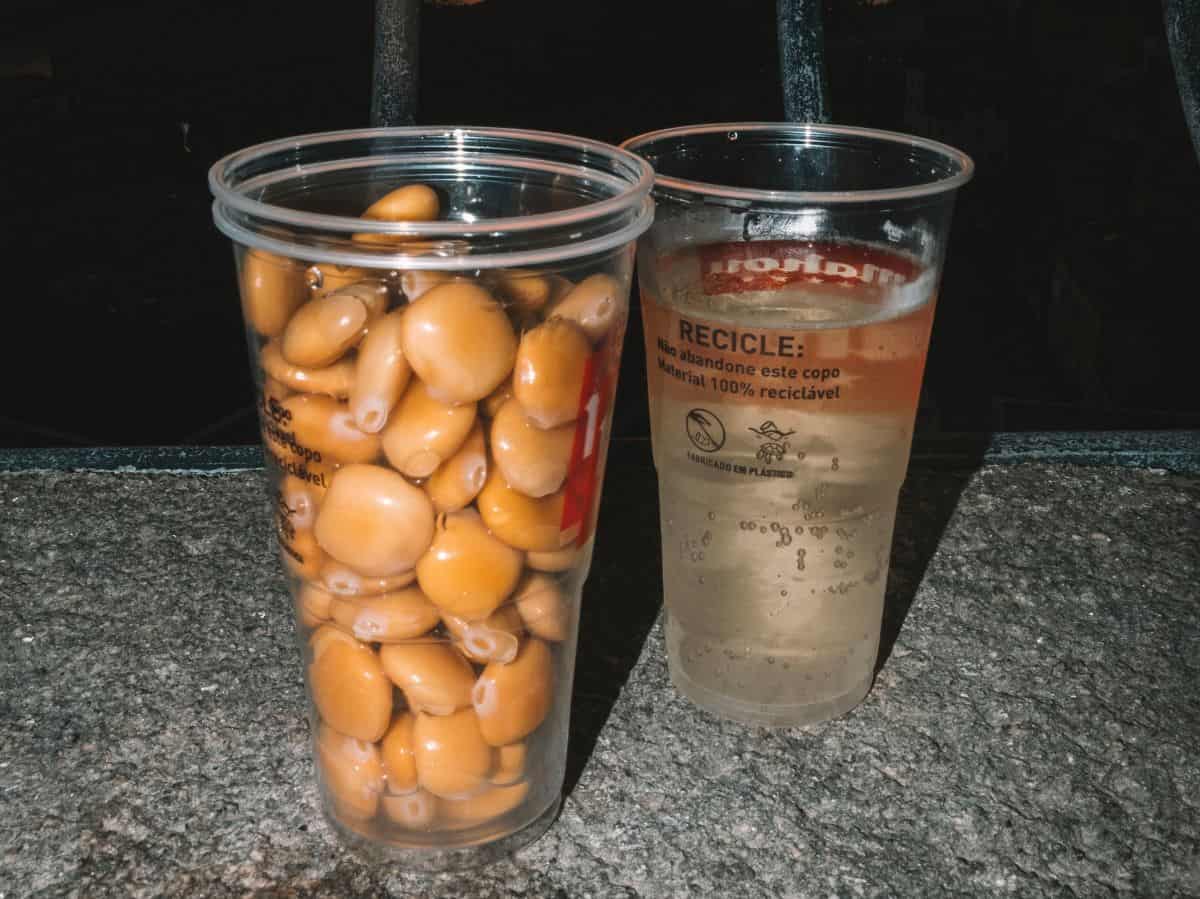
22. Cachorrinhos (Hot Dogs)
Next up on the list of traditional foods in Portugal, is the cachorrinho, or Portuguese “hot dog.” “Cachorrinho” literally translates to puppy in Portuguese, but don’t worry—it’s definitely not dog.
Fun fact: I learned that hot dog in Spanish is literally “perro caliente” on my recent trip to Colombia.
This is the ultimate drinking snack: savory sausage, melted cheese, and a spicy sauce tucked between long slices of crispy bread and cut into bite-sized pieces. You’d be remiss not to try one of these delicious “dogs” on your next trip to Porto.
We squeezed in a visit to República dos Cachorros 2 on our last day in Porto after our day trip/wine tour to the Douro Valley—and thank God we did. We needed something to soak up 8 hours of wine and port. Unfortunately, our first choice for cachorrinhos—the original Gazela Snack Bar—was closed on Sundays, so we headed to our second choice. Although they were perfect for soaking up alcohol, I have a feeling we missed out by not trying out the original cacchorinhos from Gazela.
📍 Where to Try Cachorrinhos:
- Gazela Snack Bar (Porto)
- República dos Cachorros 2 (Porto)
- Cervejaria Gazela (Porto)
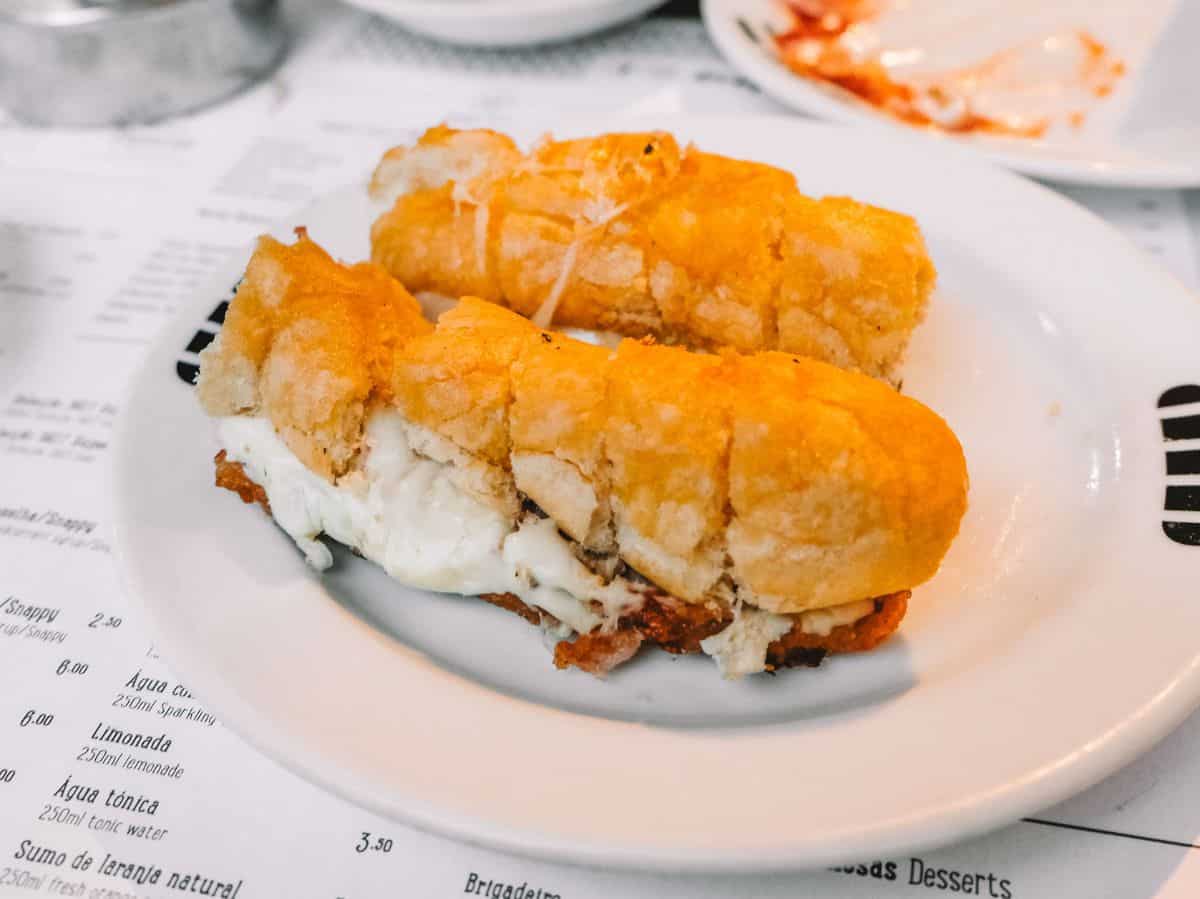
23. Chouriço à Bombeiro (Flaming Chorizo)
Did someone say flaming chorizo? Oh yeah, I did—in Lagos while I ate flaming chorizo.
Chouriço à bombeiro, or flaming chorizo, is an absolute showstopper and one of the most beloved traditional Portuguese foods in the country. It’s exactly what it sounds like—a sausage that is set on fire right in front of your very eyes (watch your hair!). The chorizo is typically served on a small, oval-shaped ceramic grill, coated in high-proof alcohol, and ignited at the table. The result is a beautifully charred and smoky sausage with flavors that you’re going to want to pack in your Carl Friedrik suitcase (but that’s probably not allowed).
We tried chouriço à bombeiro for the first time at a darling restaurant in the Algarve, Barbosa Bar and Kitchen. Unfortunately, as per usual, I was using my Fujifilm camera on the wrong setting and failed to capture a clear photo of the actual flames 🤦🏽♀️ but what are you gonna do. If you find yourself exploring the traditional dishes of Portugal, make sure to add this flaming delight to your must-try list!
📍 Where to Try Chouriço à Bombeiro:
- Barbosa Bar and Kitchen (Lagos)
- A Taberna (Amarante)
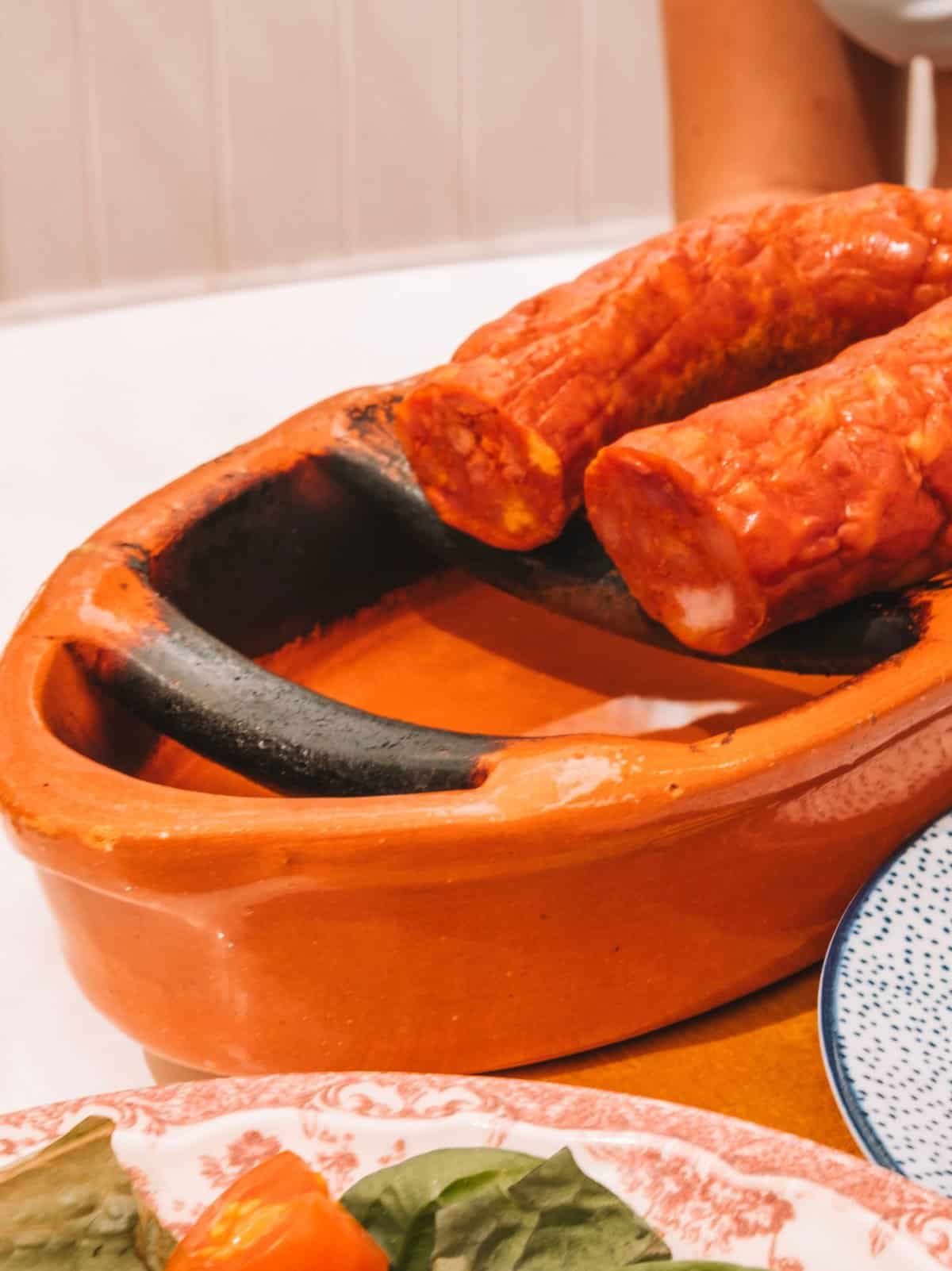
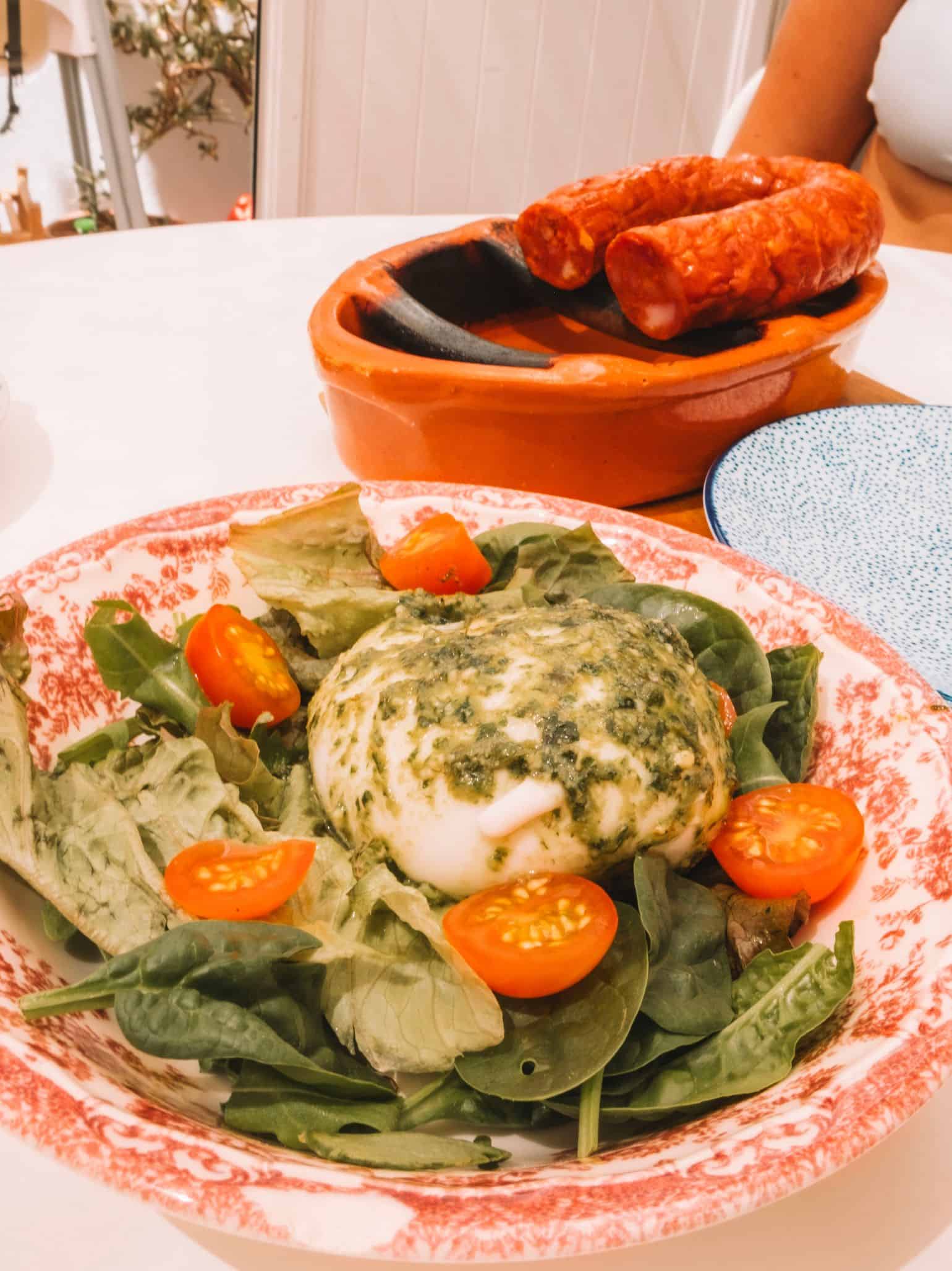
24. Bolo do Caco (Madeiran Bread)
It’s true—I looooove bread. Whether it’s the chewy tortilla around a Honduran baleada, a French baguette I bought in the French Riviera, or a bowl of creamy carbonara in Rome—I love it all.
Portuguese bread is pretty fucking awesome in general (excuse my French), but then you discover bolo do caco while visiting Madeira Island in September…and your life changes forever.
Bolo do caco is a round, somewhat flat loaf of bread, lightly charred and with a slightly crispy crust, but so soft and chewy on the inside that it’s nothing short of orgasmic. Traditionally, bolo do caco is made from sweet potato flour, which gives it a unique texture and a hint of natural sweetness.
The origins of this delightful bread trace back to Madeira—hands-down one of the most beautiful islands in the world. The name “bolo do caco” comes from the way it’s baked—on a flat basalt stone slab called a “caco,” over an open fire. The bread is usually served warm and slathered with garlic butter, which makes it somehow even more delicious (I thought that was impossible). On the streets of Madeira, they also sell it stuffed with chorizo, bacon, and cheese.
📍 Where to Try Bolo do Caco:
- Bolo do Caco Gelados (Funchal, Madeira)
- Caso do Bolo do Caco (Funchal, Madeira)
- Madeirinha Cafés (Funchal, Madeira—for a prego sandwich served on bolo do caco)
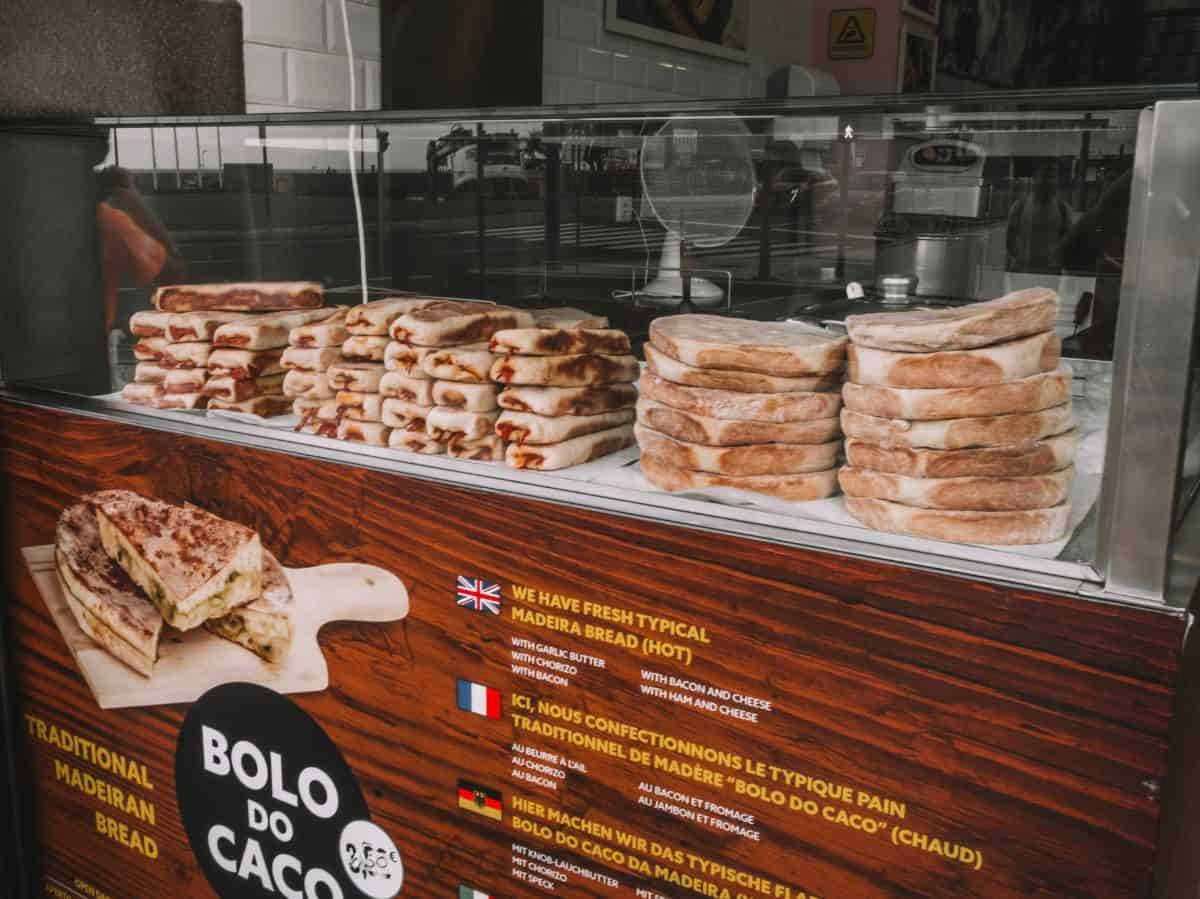
25. Poncha
I spent a good two hours at Rei da Poncha in Madeira taking tiny sips out of poncha shots and playing a drinking game with my friends to determine who had to drink the gross flavors.
Poncha is delicious…but there’s definitely a limit to how much you want to drink. Although let’s be honest, how am I supposed to resist a shot flight that looks like this? 👇🏼
This traditional Madeiran beverage is a blend of aguardente de cana (sugar cane rum), honey, sugar, lemon juice, and various fruit juices, such as orange or passion fruit. It’s customarily prepared using a special wooden tool called a “caralhinho” (unfortunately translating to “little cock”) to mix the ingredients. Then it’s sold to tourists who drink way too much of it and get really drunk before their fanciest Madeiran dinner reservation.
If you can control yourself better than I did, be sure to add poncha to your list of traditional Portuguese foods and drinks to try during your trip!
📍 Where to Try Poncha:
- Rei da Poncha (Funchal, Madeira)
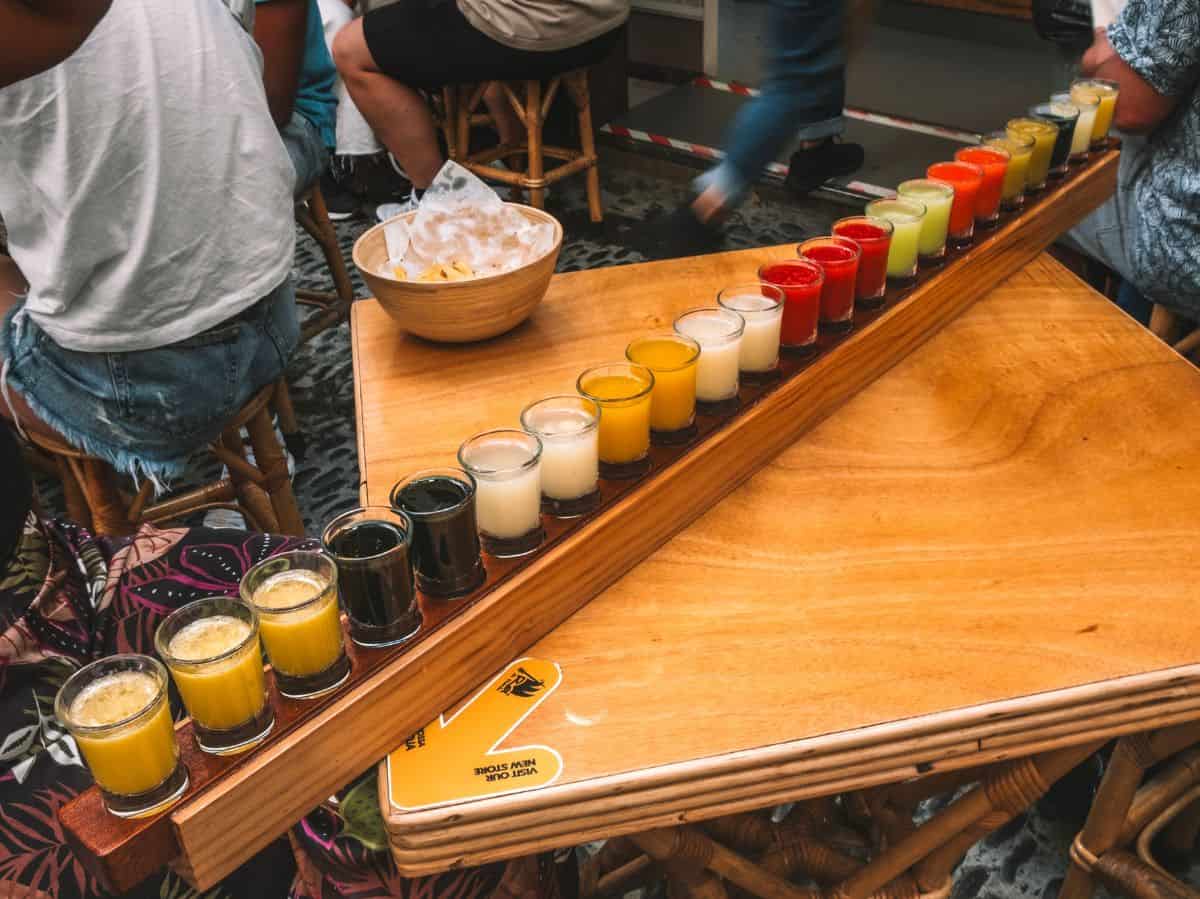
26. Lapa (Limpets)
We Bolted (a must-have app for Portugal that’s basically European Uber) our asses all the way to Marisqueira O Barqueiro to try limpets—flat, snail-like mollusks that are commonly eaten in Portugal. Sadly, the restaurant was out of limpets for the night 😭 so I never got to try them during my trip.
Lapa (or limpets) are commonly served grilled with butter and garlic with a lemon wedge and a slice of tasty bread on the side. I’m a seafood lover (I just got back from eating my weight in seafood in Santa Marta, Colombia), so all of this sounds absolutely amazing to me.
Plan better than I did, and be sure to add lapa to your list of traditional food in Portugal!
📍 Where to Try Lapa:
- Marisqueira O Barqueiro if they have them (Funchal, Madeira)
- Muralha’s Bar (Caniçal, Madeira)
- Taberna Ruel (Funchal, Madeira)
27. Travesseiro (Pillow Cakes)
If you’re a dessert person, you’re not going to want to miss out on this sugar-filled traditional Portuguese food!
This flaky, sugary pastry is known as “travesseiro”—literally translating to “pillow” in Portuguese. They are crispy and flaky on the outside, while the inside is filled with a creamy combination of egg yolks, almond paste, and sugar. You can also find travesseiro with other fillings, such a Nutella or fruit filling.
When it comes to trying travesseiro, there’s really only one option—Casa Piriquita in Sintra. They’ve been serving these babies since 1862 and have become a charming tradition for both locals and tourists.
📍 Where to Try Travesseiro:
- Casa Piriquita (Sintra)

28. Arroz de Pato (Duck Rice)
Arroz de Pato, or duck rice, is another dish you absolutely must try when visiting Portugal. I first had the pleasure of tasting this Portuguese traditional food in a charming little restaurant in Madeira called Rustikus. The combination of tender duck meat, perfectly cooked rice, and savory herbs was absolutely delicious—and well worth the €10 I paid (and that included a glass of wine!).
If you’re a fan of comforting, hearty meals, then Portuguese duck rice is a must-try. It’s a testament to the depth and variety of Portugal’s gastronomic heritage.
📍 Where to Try Arroz de Pato:
- Rustikus (Funchal, Madeira)
- Zé da Mouraria (Lisbon)
- Café no Chiado (Lisbon)
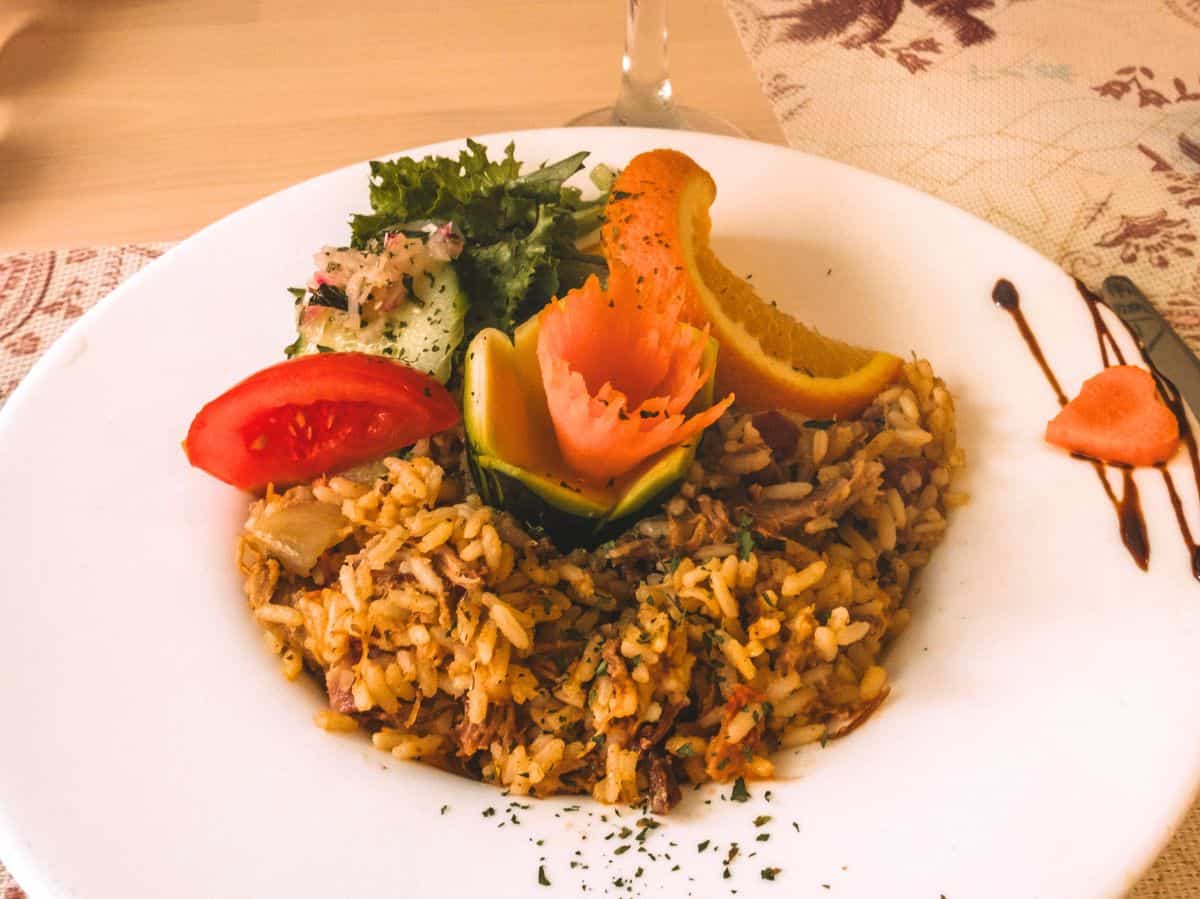
29. Leitão Assado (Suckling Pig)
Last, but definitely not least on the list of traditional Portuguese foods is leitão assado—or suckling pig. I first fell in love with suckling pig on my trip to Ubud, Indonesia where I tried babi guling. Sadly, due to all of the best restaurants being located quite a ways outside of Lisbon, I never got to try the Portuguese version.
But that doesn’t mean you can’t!
Leitão assado is traditionally prepared by basting and roasting a young pig, since it has the most tender and flavorful meat. The best place to try this dish is the Bairrada wine region, specifically in Mealhada where the pigs are considered the best in all of Portugal. The meat is rubbed with fat and spices, is skewered on a pole before being roasted in an oven, and finally is served with orange slices, french fries, and a small salad.
📍 Where to Try Leitão Assado:
- Pedro dos Leitões (Mealhada)
- Rei dos Leitões (Mealhada—Michelin ⭐️)
- Afonso dos Leitões (Lisbon)
The Best Food Tours in Portugal
If you want to be sure you taste the best that Portugal has to offer, why not sign up for one of the many food tours offered in pretty much every Portuguese city? Below are some highly-rated food tours on Viator that are sure to give you a great overview of Portuguese cuisine in the shortest amount of time (and for a great price!).
- Classic Food Tour – Lagos (⭐️ 5/5)
- Tastes & Traditions of Lisbon Food Tour (⭐️ 5/5)
- Porto Walking Food Tour With Secret Food Tours (⭐️ 5/5)
- Lisbon Walking Food Tour: Tapas and Wine with Secret Food Tours (⭐️ 5/5)
- Craft Beer & Food Tour in Porto (⭐️ 5/5)
Traditional Portuguese Foods FAQ:
What is the traditional food of Portugal?
Portugal’s traditional food is characterized by its rich flavors and diverse ingredients, many of which reflect the country’s maritime heritage. Key staples include seafood such as bacalhau (salt cod), which can be prepared in numerous ways, and shellfish like clams and octopus. Meat dishes, such as chouriço à bombeiro (flaming chorizo) and leitão assado (suckling pig), also hold significant places in Portuguese cuisine. Portugal also loves their sandwiches; with the prego, bifana, Francesinha, and cachorrinho being favorites throughout the country. Lastly, you can’t forget about the pastries, with the iconic pastéis de nata (custard tarts) being a must-try.
What is the national dish of Portugal?
The national dish of Portugal is bacalhau, also known as cod. This dried and salted fish has been a staple in Portuguese cuisine for centuries and is so beloved that it is said there are more than 365 different ways to prepare it—one for each day of the year!
Is Brazilian and Portuguese food the same?
While Brazilian and Portuguese cuisines share common roots and some similarities due to Portugal’s colonization of Brazil, they are distinct in many ways. Portuguese food tends to emphasize seafood and the use of Mediterranean ingredients like olive oil, garlic, and fresh herbs. Brazilian cuisine, on the other hand, reflects its diverse cultural heritage, incorporating influences from native, African, and other immigrant communities. Thus, while there are overlaps, especially in techniques and some ingredients, Brazilian and Portuguese food each have unique characteristics and flavors.
Is food expensive in Portugal?
Generally, food in Portugal is quite affordable compared to other Western European countries. Dining out at local restaurants and enjoying traditional dishes often provides great value for money, especially when venturing outside the main tourist areas. Markets offer a wide range of fresh produce, seafood, meats, and regional products at reasonable prices, making it budget-friendly for both locals and tourists. However, like anywhere else, dining in high-end restaurants or purchasing imported goods can be relatively more expensive. Overall, enjoying the rich and diverse traditional Portuguese foods doesn’t have to break the bank.
Do you tip at restaurants in Portugal?
Tipping at restaurants in Portugal is not a strict requirement, and the practice is more relaxed compared to other countries like the United States. While service is typically included in the bill, it is customary to leave a small tip if the service was good and you are pleased with your experience. A tip of around 5-10% of the total bill is generally considered generous. For smaller purchases or casual dining situations, simply rounding up the bill or leaving some small change is appreciated.
Is it easy to eat vegetarian in Portugal?
Eating vegetarian in Portugal is becoming increasingly easier as the country adapts to diverse dietary preferences. While traditional Portuguese cuisine is often meat and seafood-centric, many restaurants and eateries now offer vegetarian options. Cities like Lisbon and Porto boast a variety of vegetarian and vegan restaurants that cater specifically to plant-based diets. Supermarkets and local markets also provide ample fresh fruits, vegetables, legumes, and other staples necessary for a vegetarian lifestyle. Although rural areas might have fewer vegetarian-specific options, adapting traditional recipes or finding veggie-friendly dishes is usually quite manageable in Portugal.
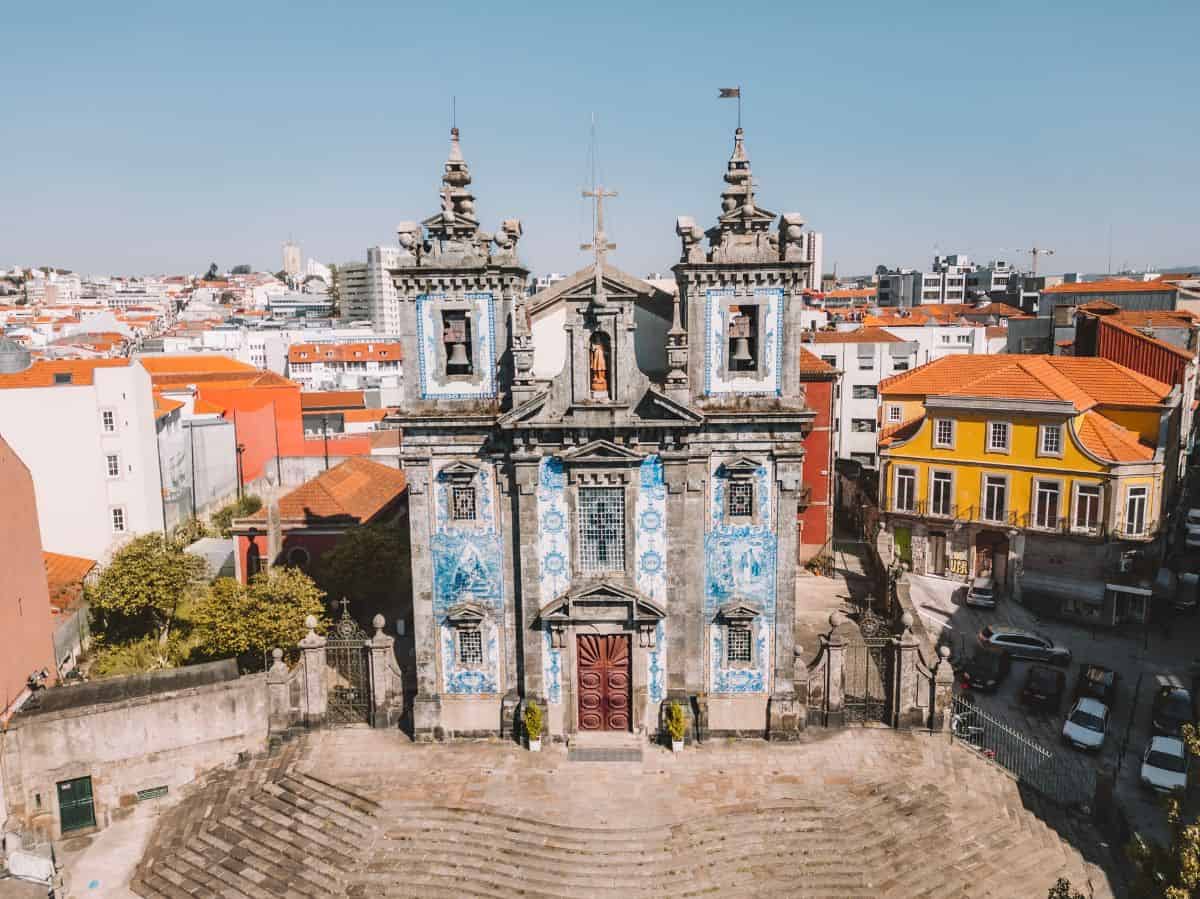
Final Thoughts
In wrapping up our culinary journey through Portugal, I hope you’ve found some inspiration to explore the incredible flavors this country has to offer. Traditional Portuguese foods have a unique charm, combining rich history with seriously tasty flavors.
My personal favorites (as a seafood and alcohol-lover) are the bacalhau à brás, polvo a lagareiro, and vinho verde—but I’ll never say no to a good bifana or a piece of bolo do caco in Madeira. It certainly was an adventure exploring Portugal’s diverse culinary scene, but thankfully there’s plenty left to enjoy and explore in this beautiful European country.
No matter your dietary preferences, I highly encourage you to get out and learn more about Portuguese food traditions on your next trip to the Iberian Peninsula. Trust me, your taste buds will thank you. Bom apetite and happy travels!
If you enjoyed this list of the best traditional Portuguese foods to try on your next trip, you might enjoy the related Portugal content below. Be sure to follow along for the adventure on Instagram @madisonsfootsteps!

Pin this Post
